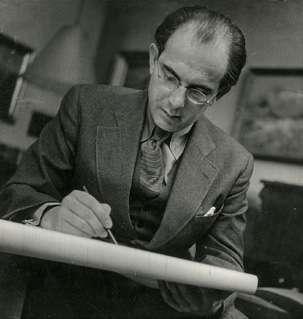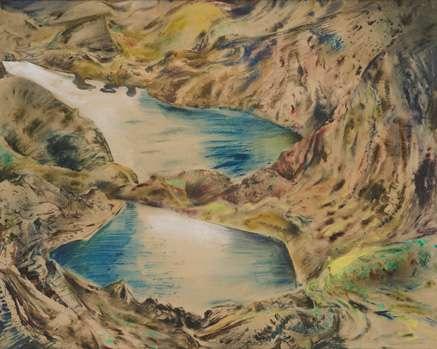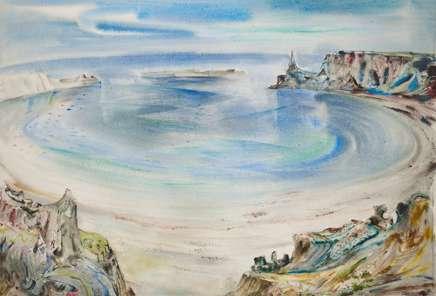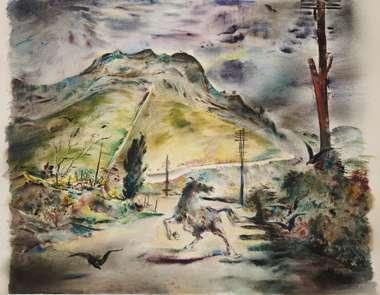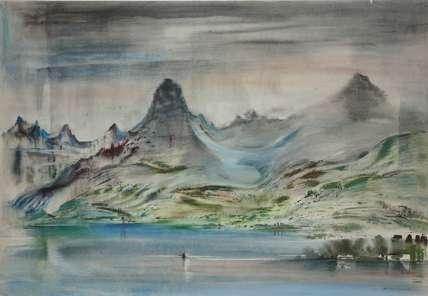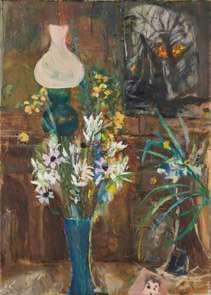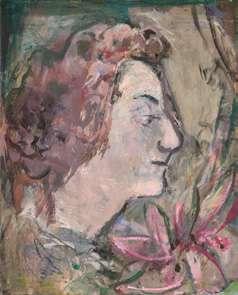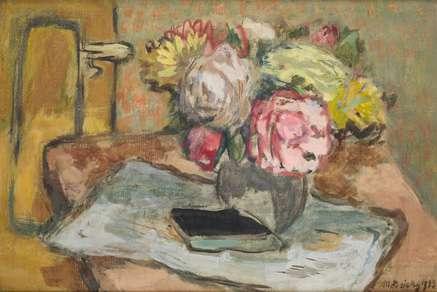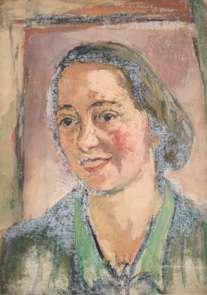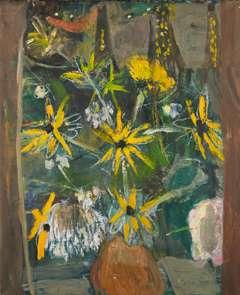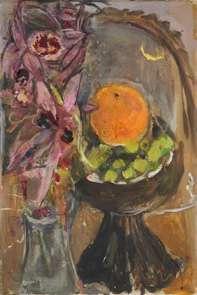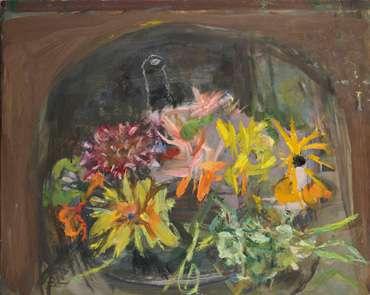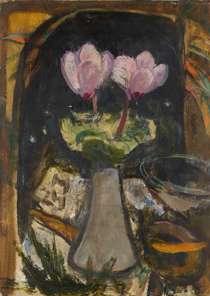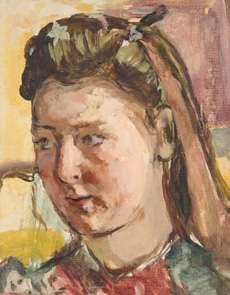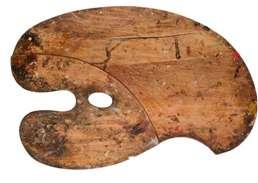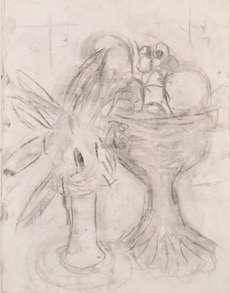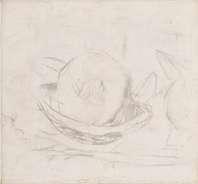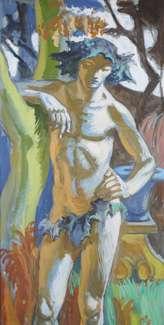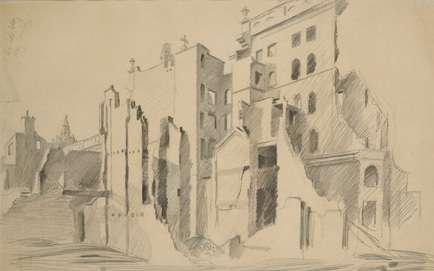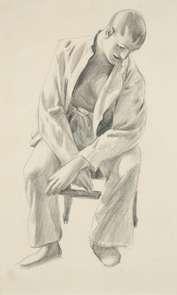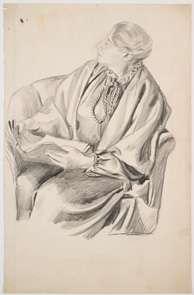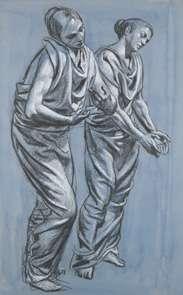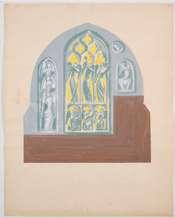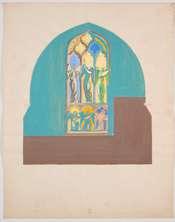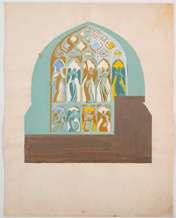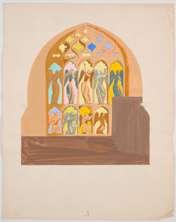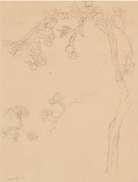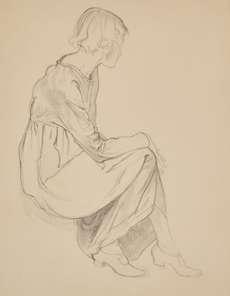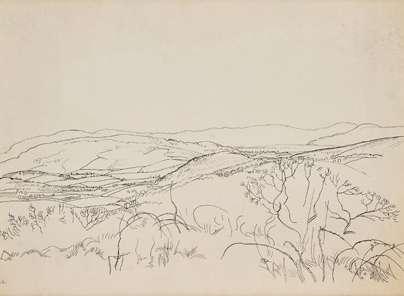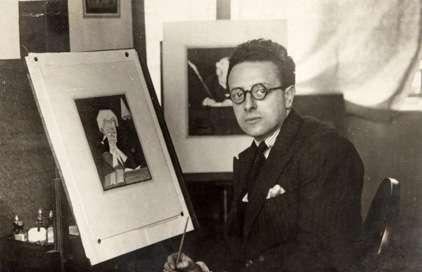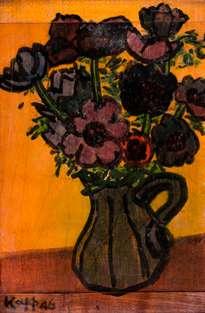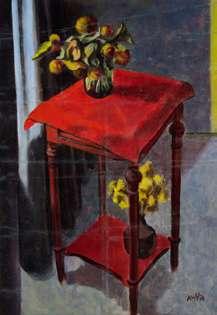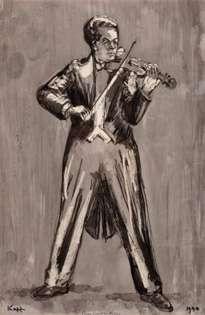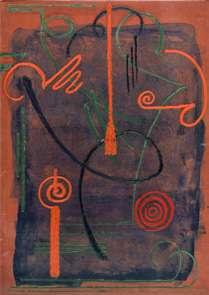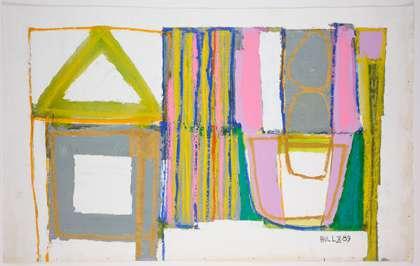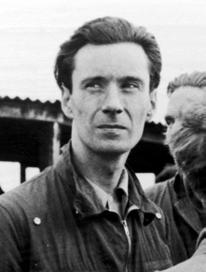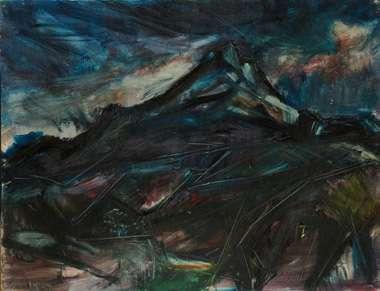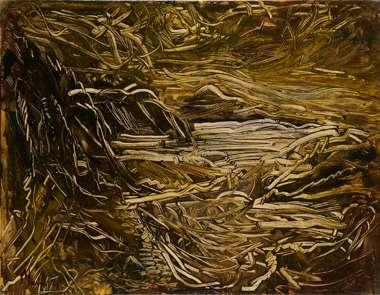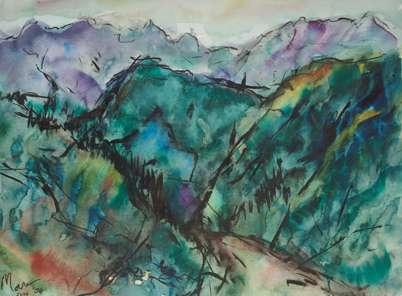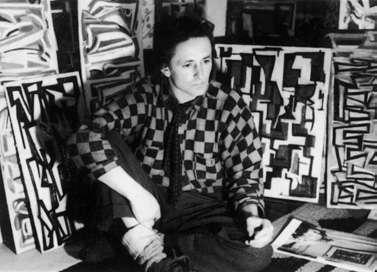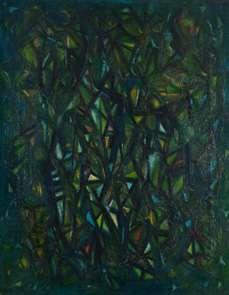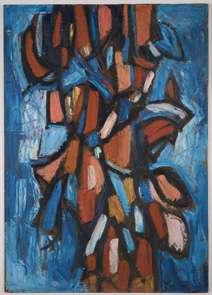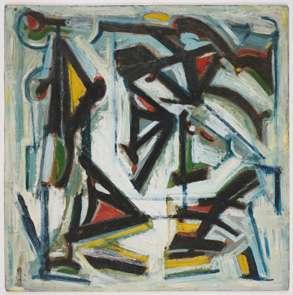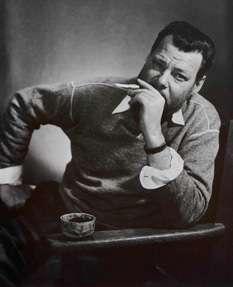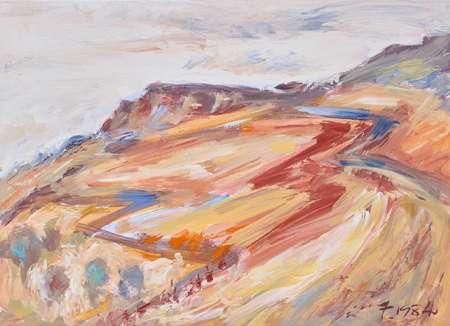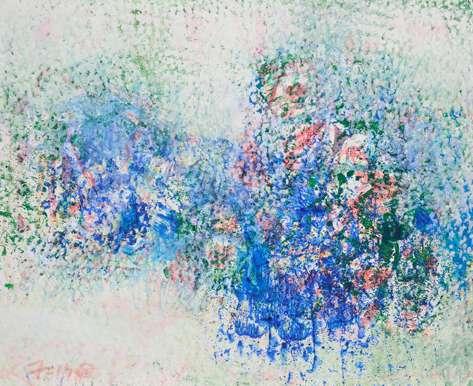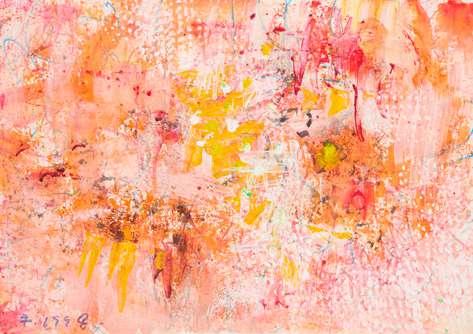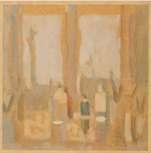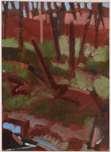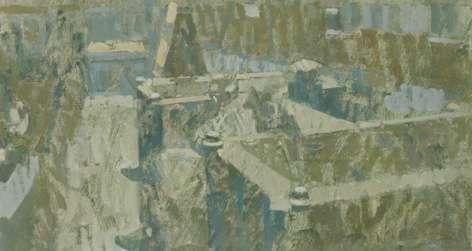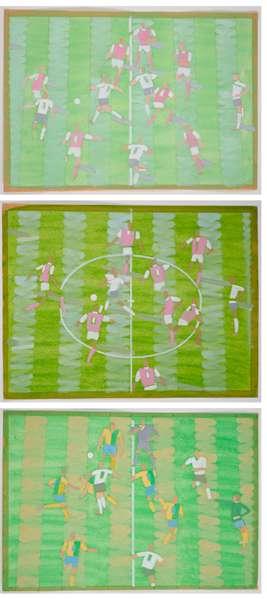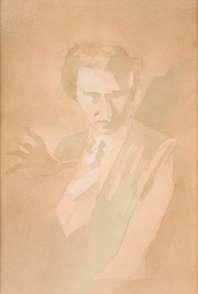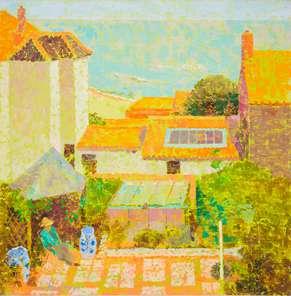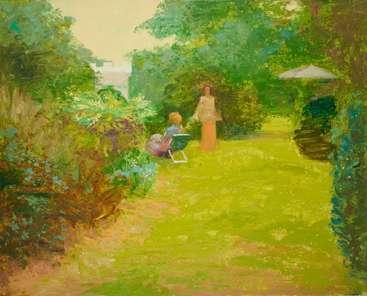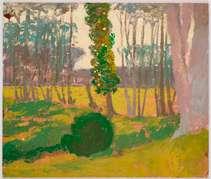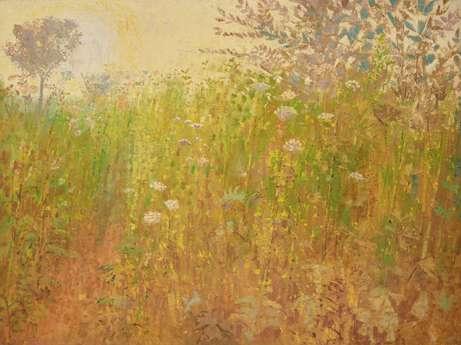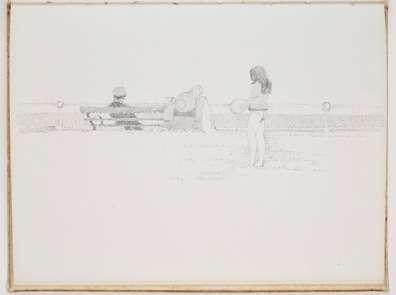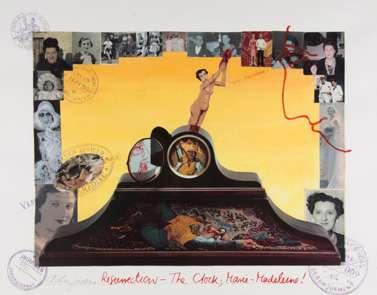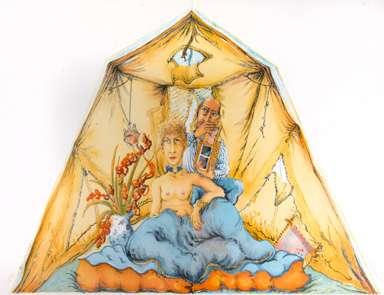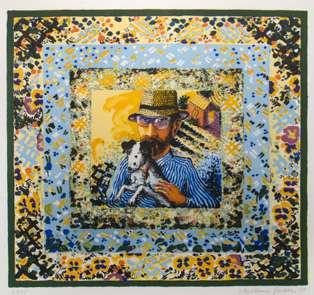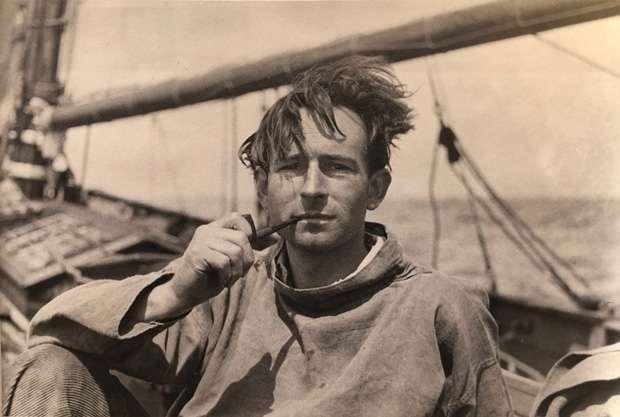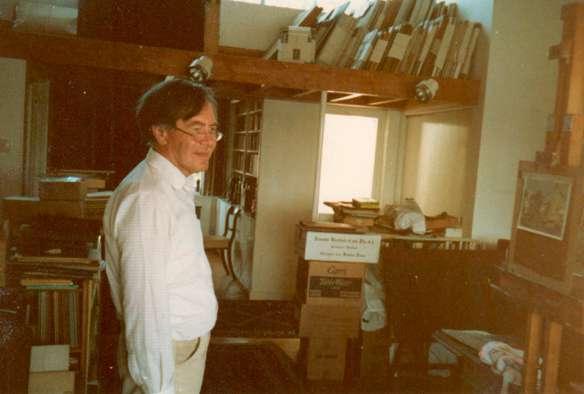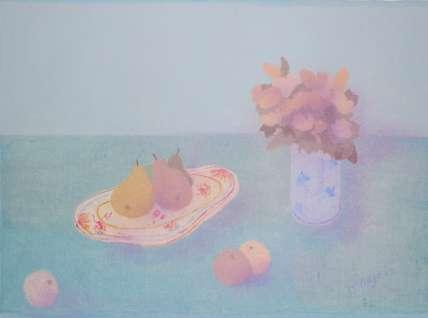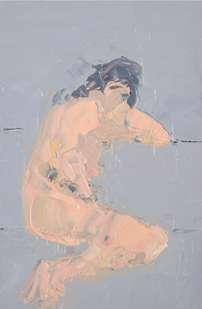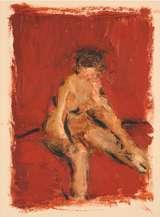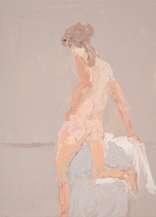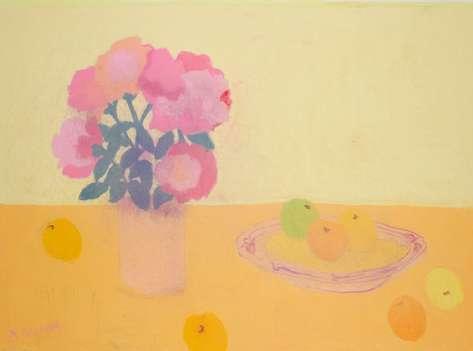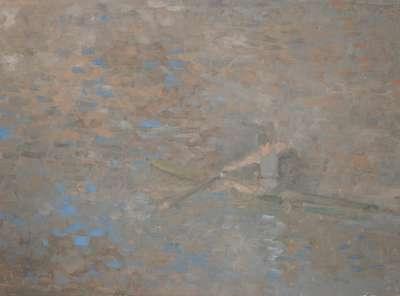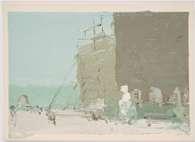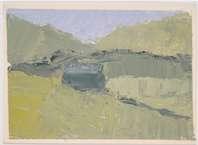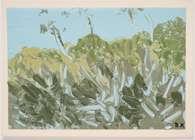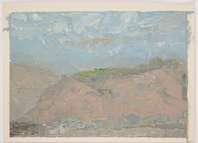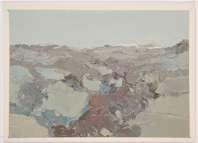THE
MARIE-LOUISE VON MOTESICZKY CHARITABLE TRUST (LOTS 12-43)
Marie-Louise von Motesiczky (1906-1996) grew up in Vienna, but when Austria was annexed by Germany in 1938 she and her mother fled via Holland to England where she lived and painted until she died in her ninetieth year.
A seminal influence on her work was Max Beckmann (1884-1950) whom she met in 1920. She recalled: ‘A winged creature from Mars could not have made a greater impact on me’ and they remained in regular contact until the end of his life. Beckmann visited her in Paris, she attended his master classes in Frankfurt 1927-28 and they stayed in contact as far as possible during his exile in Holland from 1937-47, travelling to visit him and his wife ‘Quappi’ before they left for the United States.
Marie-Louise had been born into a cultured Jewish banking dynasty. Her maternal grandfather, Leopold von Lieben, was President of the Stock Exchange in Vienna, she counted the Todescos, and Ephrussis among her family circle, and her grandmother Anna was one of Freud’s early patients. Over time the family was stricken by tragedy and financial and political turmoil. Marie-Louise’s father died in a hunting accident in 1909, her mother’s income was reduced during the post First World War by high taxation and the failure of the family bank in 1932, and the Anschluss on 13 March 1938 impelled her to leave Vienna immediately with her mother. Her brother Karl did not do so, mistakenly thinking he could continue his studies and look after the family property. He was arrested in October 1942 for aiding Jewish refugees and deported to Auschwitz, dying of typhus on 25 June 1943.
In London Marie-Louise reconnected with Oskar Kokoschka (1886-1980), a family friend from Vienna now similarly in exile. Kokoschka arranged for her work to be exhibited in London, including a show at the Czechoslovak Institute in 1944. It was in Britain that she found her own ‘voice’ as an artist, living in Amersham during the war years, then a rented flat in West Hampstead and finally a large house on Chesterford Gardens in Hampstead. Another figure central to her life for nearly thirty years was the Nobel prize-winning writer Elias Canetti (1905-94), who is commemorated on the plaque dedicated to the two of them at the house in Chesterford Gardens.
But starting afresh in Britain proved challenging for Marie-Louise, and it was not until 1960 that she had a second solo show at the Beaux Arts Gallery. In contrast, on the Continent her work was exhibited in Amsterdam and The Hague in 1952, a canvas being purchased by the Stedelijk Museum; she showed in Munich (1954) and Düsseldorf (1955), and in the 1960s she enjoyed further shows in both Austria and Germany. Then, in 1985, her work was exhibited again in London at the Goethe-Institut. The catalogue included contributions by Tate curator Richard Calvocoressi, Gunther Busch, former director of the Kunsthalle in Bremen, and the renowned cultural historian and fellow émigré Sir Ernst Gombrich.
The exhibition re-ignited interest in her work, and in the years that followed her work was shown across Europe. A centenary exhibition travelled from Britain to Germany and Austria in 2006-7, her biography written by Jill Lloyd was published in 2007, followed in 2009 by a catalogue raisonné compiled by Ines Schlenker. In 2019 the ‘Marie-Louise von Motesiczky Archive Gallery’ was inaugurated at Tate Britain where the archive of her papers, photographs and the bulk of her drawings and sketchbooks are held and fully catalogued online. Her work is now in the collections of national, regional, local and university museums in Britain, Ireland, Austria, Germany, Netherlands and the United States. A major self-portrait of 1959 is on display at the National Portrait Gallery in London, following its reopening in June 2023.
Literature Reference: the full reference for Schlenker, abbreviated in lots 12-43, is: Ines Schlenker, Marie-Louise von Motesiczky, A Catalogue Raisonné of the Oil Paintings, London, 2009.
The Marie-Louise von Motesiczky Charitable Trust, is a company limited by guarantee registered in England and Wales (no. 7572024) and a registered charity (no. 1140890): www.motesiczky.org. The copyright for Marie-Louise von Motesiczky’s paintings, drawings and correspondence or other written work originating from her, her mother Henriette and brother Karl, lies with the Marie-Louise von Motesiczky Charitable Trust.
12
MARIE-LOUISE VON MOTESICZKY
(AUSTRIAN-BRITISH 1906-1996)
SELF-PORTRAIT
watercolour and pastel on paper
11 x 16cm; 4 1/4 x 6 1/4in
31 x 39cm; 12 1/4 x 15 1/4in (framed)
⊕ £100-200
13
MARIE-LOUISE VON MOTESICZKY
(AUSTRIAN-BRITISH 1906-1996)
STILL-LIFE WITH FLOWERS AND OIL-LAMP
oil and pastel on canvas
53 x 38cm; 21 x 15in
unframed
Painted in 1990-91.
Literature Schlenker, no. 311
As Schlenker suggests, the vases of flowers, oil lamp and glimpses of the sun setting through trees combined with a cropped photograph of an unidentified person in the lower right of the canvas lends the present composition a distinct air of mystery. Schlenker notes that Motesiczky frequently incorporated photographs (or her own reflection in a mirror) in her compositions, thereby infusing them with a more personal touch and a further layer of meaning (Schlenker, p. 482).
⊕ £500-700
14
MARIE-LOUISE VON MOTESICZKY
(AUSTRIAN-BRITISH 1906-1996)
THE ARTIST’S PALETTE oil on panel
47 x 30cm; 18 1/2 x 11 3/4in
⊕ £200-300
15
MARIE-LOUISE VON MOTESICZKY
(AUSTRIAN-BRITISH 1906-1996)
WAITING AT THE AIRPORT oil on canvas
52 x 69.5cm; 20 1/2 x 27 1/4in unstretched
Painted in the 1950s.
Literature Schlenker, no. 164
⊕ £300-500
16
MARIE-LOUISE VON MOTESICZKY
(AUSTRIAN-BRITISH 1906-1996)
FEMALE HEAD
oil, charcoal and pastel on canvas
50.5 x 40.5cm; 20 x 16in (unframed)
Painted circa 1994-95. Schlenker notes that this portrait probably began as a likeness of Pia-Maria Kerman, the mother of Michael Kerman who was a lodger at 6 Chesterford Gardens, Hampstead, but that Marie-Louise re-worked the painting (Schlenker p. 517).
Literature
Schlenker no. 328
⊕ £300-500
17
MARIE-LOUISE VON MOTESICZKY (AUSTRIAN-BRITISH 1906-1996)
STILL-LIFE, APPLES AND FLOWERS IN BLUE VASE oil on canvas
51 x 38cm; 20 x 15in unframed
Painted in 1993.
Literature
Schlenker, no. 321
⊕ £500-700
18
MARIE-LOUISE VON MOTESICZKY (AUSTRIAN-BRITISH 1906-1996)
PORTRAIT OF A YOUNG GIRL IN A BLUE DRESS oil on board
46 x 37cm; 18 x 14 1/2in (unframed)
Painted in 1952, according to Schlenker the present work may have been painted whilst Marie-Louise was on holiday in the south of France (Schlenker p. 224).
Literature
Schlenker no. 113
⊕ £300-500
19
MARIE-LOUISE VON MOTESICZKY (AUSTRIAN-BRITISH 1906-1996)
STILL-LIFE WITH FLOWERS AND MEAT SAFE oil on canvas
30 x 45cm; 12 x 17 3/4in unframed
Painted in the 1970s, Schlenker observes that in the right background is a wire-mesh meat safe, identifiable by its golden knob on the top and wire mesh, and next to it is a cream-coloured ceramic dish, topped by a decorative handle (Schlenker p. 446).
Literature Schlenker, no. 267
⊕ £300-500
20
MARIE-LOUISE VON MOTESICZKY
(AUSTRIAN-BRITISH 1906-1996)
STILL-LIFE, VASE OF FLOWERS AND WICKER CHAIRS
oil and charcoal on canvas
35 x 45cm; 13 3/4 x 17 3/4in unstretched
Painted in the 1980s, Schlenker comments that among the flowers in the present work are fuschia, pink roses and rudbeckia.
Literature
Schlenker, no. 304
⊕ £300-500
21
MARIE-LOUISE VON MOTESICZKY
(AUSTRIAN-BRITISH 1906-1996)
MARGIT DÖRY
oil on canvas
41 x 31cm; 16 x 12 1/4in unframed
Painted in 1963, the sitter is Margit Baronin Döry de Jobbaháza (1896-1988) who lived in Vienna and had been married to Heinrich von Lieben, Henriette von Motesiczky’s cousin. Motesiczky had painted Margit’s son Nicolas Lytton in 1956.
Literature
Schlenker, no. 188
⊕ £300-500
22
MARIE-LOUISE VON MOTESICZKY
(AUSTRIAN-BRITISH 1906-1996)
STILL-LIFE WITH YELLOW ROSES
signed and dated Motesicky 1943 lower right oil on canvas
42 x 61.5cm; 16 1/2 x 24 1/4in; 41 x 65.5cm; 16 x 25 3/4in (framed)
A related charcoal study of the present work is in the Motesiczky Archive, Tate Britain (Schlenker, p. 162, fig. 66).
Provenance with the Beaux Arts Gallery, London (early 1960s)
Literature
Schlenker, no. 62
⊕ £500-700
23
MARIE-LOUISE VON MOTESICZKY
(AUSTRIAN-BRITISH 1906-1996)
HEAD OF A SMILING WOMAN
oil on canvas
50 x 35cm; 19 3/4 x 13 3/4in unstretched
Painted in the 1940s.
Literature
Schlenker, no. 94
⊕ £300-500
24
MARIE-LOUISE VON MOTESICZKY
(AUSTRIAN-BRITISH 1906-1996)
STILL LIFE WITH DAHLIAS oil and charcoal on canvas
62 x 48cm; 24 1/2 x19in
69 x 55.5cm; 27 1/4 x 21 3/4 (framed)
Painted in 1992.
Literature
Schlenker, no. 317
⊕ £500-700
25
MARIE-LOUISE VON MOTESICZKY
(AUSTRIAN-BRITISH 1906-1996)
PORTRAIT OF ‘AU PAIR’ BARBARA
signed with initials and dated 92 upper right oil on canvas
46 x 40.5cm; 20 x 14in unframed
Painted in 1992, the sitter was Barbara Valentina Berner (b.1972). Originally from Vienna, she lodged with Marie-Louise for a few months in the early 1990s, helping with housework and keeping her company. A related pencil study of the sitter is in the Motesiczky Archive, Tate Britain (Schlenker, p. 506, fig. 250).
Literature
Schlenker no. 316
⊕ £300-500
26
MARIE-LOUISE VON MOTESICZKY
(AUSTRIAN-BRITISH 1906-1996)
STILL-LIFE WITH RUDBECKIA oil, pastel and charcoal on canvas
56 x 45.5cm; 22 x 18in unframed
Painted in the early 1990s.
Literature
Schlenker, no. 326
⊕ £500-700
27
MARIE-LOUISE VON MOTESICZKY
(AUSTRIAN-BRITISH 1906-1996)
TWO BEARDED MEN BY A LAKE oil on canvas
50.5 x 71cm; 20 x 28in unstretched
Literature
Schlenker, no. 333
⊕ £200-300
28
MARIE-LOUISE VON MOTESICZKY
(AUSTRIAN-BRITISH 1906-1996)
WOMAN IN PROFILE
oil on canvas
46 x 32cm; 18 x 12 1/2in (unframed)
Painted in the late 1950s, Schlenker thinks it most likely that the model is Mexican. Marie-Louise visited Mexico in 1956 where she was inspired by Diego Rivera and his depiction of calla lilies, a flower that the sitter carries (Schlenker, p. 300). There is an unfinished portrait on the reverse.
Literature
Schlenker no. 161
⊕ £300-500
29
MARIE-LOUISE VON MOTESICZKY
(AUSTRIAN-BRITISH 1906-1996)
STILL-LIFE, HEATHER AND APPLE oil on canvas
38 x 53cm; 15 x 20 3/4in
52.5 x 67.5; 20 3/4 x 26 1/2in (framed)
Painted in 1980, Schlenker notes that Motesiczky arranged this still life on the draining board in the old-fashioned scullery next to the dining room at Chesterford Gardens. (Schlenker, p. 447).
Literature
Jill Lloyd, The Undiscovered Expressionist, A Life of Marie-Louise von Motesiczky, London, 2007, p. 219
Schlenker, no. 269
⊕ £500-700
30
MARIE-LOUISE VON MOTESICZKY
(AUSTRIAN-BRITISH 1906-1996)
MAN WITH GREEN SCARF oil on canvas
61 x 50.5cm; 24 x 20in unframed
Painted in 1975, the sitter was John Sandemeyer (d.1990), who lodged in the basement of the Motesiczky’s house in Chesterford Gardens.
Literature
Schlenker, no. 249
⊕ £300-500
31
MARIE-LOUISE VON MOTESICZKY (AUSTRIAN-BRITISH 1906-1996)
HEAD OF A GIRL oil on canvas
51 x 55.5cm; 20 x 22in unframed
Painted circa 1980, the unknown model also appears in Model with Dog painted around the same time (Schlenker, no. 282). A photograph of the sitter seated in the artist’s studio is in the Motesiczky Archive,Tate Britain (Schlenker, p. 450, fig. 220).
Literature
Schlenker, no. 271
⊕ £300-500
32
MARIE-LOUISE VON MOTESICZKY
(AUSTRIAN-BRITISH 1906-1996)
FEMALE PROFILE AND BIRD oil and charcaol on canvas
35.5 x 46cm; 14 x 18in unframed
Painted in the 1960s. ‘It has been suggested that this intimate little scene… depicts the mythical encounter of Leda and the Swan’ (Schlenker, p. 391).
Literature Schlenker, no. 228
⊕ £200-300
33
MARIE-LOUISE VON MOTESICZKY
(AUSTRIAN-BRITISH 1906-1996)
ORCHID WITH BOWL AND MIRROR oil on canvas
46 x 31cm; 18 x 12in unframed
Painted in 1992, Schlenker comments that the present work combines pink orchids given to the artist by Stephan Connery with a wooden bowl from Sulawesi (Celebes), Indonesia containing an orange on a bed of grapes with a curved mirror in an intricately carved frame behind. The bowl and flowers in a vase appear in a photograph of the artist’s studio taken in 1992 and now in the Moteisczky Archive, Tate Britain (Schlenker, p. 508, fig. 251).
Literature Schlenker, no. 318
⊕ £400-600
34
MARIE-LOUISE VON MOTESICZKY (AUSTRIAN-BRITISH 1906-1996) BLONDE WOMAN oil on canvas
61 x 51cm; 24 x 21in; 76 x 64cm; 30 x 25 1/2in (framed)
Painted in 1960, Schlenker suggests that the sitter for the present work may well have been a Spanish girl called Lolita who lodged with Marie-Louise in exchange for sittings. Lolita was the model for at least two other oils (Schlenker, nos. 180 & 182).
Literature
Schlenker, no. 166
⊕ £300-500
35
MARIE-LOUISE VON MOTESICZKY (AUSTRIAN-BRITISH 1906-1996)
MIXED FLOWERS IN A VASE WITH CUTLERY oil on canvas
35.5 x 46cm; 14 x 18in unframed
Painted in the 1940s.
Literature Schlenker, no.100
⊕ £400-600
MARIE-LOUISE VON MOTESICZKY
(AUSTRIAN-BRITISH 1906-1996)
STILL-LIFE, FLOWERS
oil and pastel on canvas
41 x 50.5cm; 16 x 20in unframed
Painted in 1994.
Literature
Schlenker, no. 325
⊕ £400-600
37
MARIE-LOUISE VON MOTESICZKY
(AUSTRIAN-BRITISH 1906-1996)
INDIAN MOTHER WITH CHILD oil on canvas
61 x 51cm; 24 x 20 1/4in
70 x 60cm; 27 1/2 x 23 1/2in (framed)
Painted in 1945.
Exhibited
Munich, Städitsche Galerie, Erna Dinklage, Marie-Louise Motesiczky, 1954, no. 131 (?) - as Indische Madonna
Literature
Eva Michel, Marie-Loiuise von Motesiczky 1906-1996, Eine österreicheische Schülerin von Max Beckmann (diploma thesis), University of Vienna, 2003, p. 79, pl. 124, illustrated Schlenker, no. 76
⊕ £400-600
38
MARIE-LOUISE VON MOTESICZKY
(AUSTRIAN-BRITISH 1906-1996)
TWO CYCLAMEN IN A VASE oil on canvas
35.5 x 25.5cm; 14 x 10 1/4in unframed
Painted in 1953 / 1967. The dating of the present work to 1953 reflects the number 53 that appears in the lower left corner of the composition. But Schlenker comments that a later date of 1967 has also been suggested.
Literature
Schlenker, no. 125
⊕ £400-600
39
MARIE-LOUISE VON MOTESICZKY
(AUSTRIAN-BRITISH 1906-1996)
HEAD OF A GIRL
oil on canvas
46 x 35.5cm; 18 x 14in
52.5 x 42.5cm; 20 3/4 x 16 3/4in (framed)
Painted in the 1940s.
Literature
Schlenker, no. 92
⊕ £300-500
MARIE-LOUISE VON MOTESICZKY
(AUSTRIAN-BRITISH 1906-1996)
TWO OF THE ARTIST’S PALETTES both oil on panel each 61 x 39.5cm; 24 x 15 1/2in
⊕ £100-200
41
MARIE-LOUISE VON MOTESICZKY (AUSTRIAN-BRITISH 1906-1996)
STILL-LIFE OF FLOWERS WITH FRUIT IN A BOWL (i); STILL-LIFE OF FLOWERS (ii) both charcoal on prepared canvas each 45.5 x 35.5cm; 18 x 14in both unframed (2)
⊕ £100-150
42
MARIE-LOUISE VON MOTESICZKY
(AUSTRIAN-BRITISH 1906-1996)
PORTRAIT OF A GRINNING MAN (i); STILL-LIFE WITH FRUIT (ii); STILL LIFE WITH MELON (iii) pencil on prepared canvas (i) 36 x 26cm; 14 1/4 x 10 1/4in (ii) 31 x 41cm; 12 1/4 x 16in (iii) 23 x 25cm; 9 x 10in all unframed (3)
⊕ £100-200
43
MARIE-LOUISE VON MOTESICZKY
(AUSTRIAN-BRITISH 1906-1996)
STILL-LIFE OF FRUIT AND PAINTBRUSHES ON A TABLE charcoal and pencil on prepared canvas 81 x 61cm; 32 x 24in (unframed)
⊕ £100-150
44
No lot
HANS FEIBUSCH
(LOTS 45-75)
TO STAND BEFORE AN EMPTY WALL
as in a trance… to let shapes cloudily emerge, to draw scenes and figures, to let light and dark rush out of the surface, to make them move outward or recede into the depths, this was bliss.
(Hans Feibusch)
The son of a Frankfurt dentist, Feibusch had fought for the Kaiser in the First World War, emerged alive from the Russian Front, and had studied with Carl Hofer in Berlin and with Emil Othon Friesz and André Lhote in Paris. Come the 1930s he had a dealer in Berlin, had exhibited widely, and been awarded the German Grand State Prize for painting by the Prussian Academy of Arts. But Hitler’s rise to power threatened it all. In a meeting of the Frankfurter Künstlerbund which he attended in 1933, a new member appeared in Nazi uniform, jumped on a table and pointing at the Jews with his riding crop said: ‘You’ll never show again’. It was the moment Feibusch determined to emigrate.
Arriving in London Feibusch had his first one-man exhibition at the Lefevre Gallery, and was soon a member of the London Group. Further exhibitions with Lefevre followed; then in 1938 he completed his first large scale mural: Footwashing in the Methodist Chapel, Colliers Wood. It was a commission that would result in Feibusch becoming the leading muralist in Britain. Working both for the Church of England and local municipalities, over the next thirty-five years he decorated some forty plus churches, civic buildings and private houses across England and Wales. His work contributed hugely to the re-generation of public buildings after the War and the debate on art in public places. But it also took him away from the Mayfair-centric contemporary art world and its critics, and thus to a large extent out of the public eye and the commercial art world. After his last exhibition at the Lefevre Gallery in 1951 he didn’t have another gallery show until the late 1970s.
Instead Feibusch threw himself into large scale mural projects, designing the decorations for the tea room at the Victoria & Albert Museum in 1946, and championed by George Bell, Bishop of Chichester, embarked on a series of commissions to decorate bomb-damaged churches that were being restored and re-built. These included, for example, designs for a font for the baptistry of Christ Church and St Stephen’s, Battersea (lots 66 & 67), and a study for a mural at Priory Church, Christchurch, Dorset (lot 70). Feibusch also wrote Mural Painting a treatise on the history, theory and technique of the art in 1946, and contributed the foreward to the catalogue of the first exhibition of the Society of Mural Painters held in 1950.
A consummate draughtsman, whether sketching his surroundings (lots 53-56), or studying the model before him (lots 57-60), he captures each scene with a fine eye for detail. And as a colourist, he responded to the light of his surroundings with a breathtaking freshness and immediacy (lots 45-52). But above all it is the manner in which he places the human form at the heart of his work with such ease and fluidity that leaves an abiding impression on the viewer and makes his work so compelling today.
Exhibition Reference: the full reference for the travelling exhibition abbreviated in lots 45-75 is: Chichester, Pallant House Gallery; London, Ben Uri Art Gallery; Northampton, Museum and Art Gallery; Eastbourne, Towner Art Gallery; Newport, Museum & Art Gallery, Hans Feibusch, The Heat of Vision, 1995-97
45
HANS FEIBUSCH
(GERMAN-BRITISH 1898-1998)
STILL LIFE WITH A CLASSICAL BUST ADORNED WITH A LAUREL WREATH AND A BRANCH OF APPLES
singed with initals HF and dated 65 lower right gouache on card
37.4 x 51cm; 14 3/4 x 20in unframed
⊕ £500-700
46
HANS FEIBUSCH (GERMAN-BRITISH 1898-1998)
PROJECT FOR A BACHANAL - SET OF THREE each signed with initials and dated 74 lower right gouache on paper each 47.5 x 33cm; 18 3/4 x 13in each 61.5 x 46.5 cm; 24 1/4 x 18 1/4in (framed) (3)
⊕ £500-700
47
HANS FEIBUSCH (GERMAN-BRITISH 1898-1998)
STILL LIFE WITH VASE OF LILLIES AND SCULPTED HEAD
signed with initials and dated 90 lower right pastel on paper
47.5 x 63cm; 18 3/4 x 24 3/4in
61 x 75cm; 24 x 29 1/2in (framed)
⊕ £300-500
48
HANS FEIBUSCH (GERMAN-BRITISH 1898-1998)
STANDING FAUN
signed with initials and dated 68 lower right gouache over pencil on paper
102 x 51.5cm; 40 1/4 x 20 1/4in
120 x 69.5cm; 47 1/4 x 27 14in (framed)
⊕ £500-700
49
HANS FEIBUSCH (GERMAN-BRITISH 1898-1998)
ROARING CENTAUR
signed with initials and dated 73 lower right gouache on paper
32 x 47cm; 12 1/2 x 18 1/2in
54 x 68.5cm; 21 1/4 x 27in (framed)
⊕ £300-500
50
HANS FEIBUSCH (GERMAN-BRITISH 1898-1998)
SAYTRS DANCING AROUND A KNEELING MAN
signed with initials and dated 54 lower right gouache on paper
54.5 x 72cm; 21 1/2 x 28 1/4in
76 x 92cm; 30 x 36 1/4in (framed)
⊕ £400-600
51
HANS FEIBUSCH (GERMAN-BRITISH 1898-1998)
STUDY FOR A MURAL
signed with initials and dated 83 lower right; dedicated For Paul from Hans lower centre gouache on paper
25.5 x 37cm; 10 x 14 1/2in
45.5 x 56cm; 18 x 22in (framed)
Study for a mural to decorate Feibusch’s daughter’s home in Wavel Mews, West Hampstead.
⊕ £250-350
52
HANS FEIBUSCH (GERMAN-BRITISH 1898-1998)
ANCIENT RUINS IN TAORMINA, ITALY
signed with initials lower right oil on canvas
51 x 92cm; 20 x 36in
74 x 114cm; 29 x 45in (framed)
⊕ £600-800
53
HANS FEIBUSCH (GERMAN-BRITISH 1898-1998) BOMB DAMAGE, LONDON FROM ST MARY SOMERSET CHURCH LOOKING TOWARDS THE TOWER OF ST NICHOLAS COLE ABBEY
inscribed St Nic. Col Abbey / Mary Somerset upper left pencil on paper
22 x 35cm; 8 1/2 x 13 3/4in (image)
41.5 x 53cm; 16 x 20 3/4in (framed)
⊕ £200-300
54
HANS FEIBUSCH (GERMAN-BRITISH 1898-1998) BOMB DAMAGE, LONDON
signed with initial HF and dated 48 pencil on paper
16.5 x 23cm; 6 1/2 x 9in unframed
⊕ £150-250
55
HANS FEIBUSCH (GERMAN-BRITISH 1898-1998)
DERELICT INDUSTRIAL SITE WITH CHIMNEY pencil on paper
22 x 36cm; 8 3/4 x 14in unframed
⊕ £150-250
56
HANS FEIBUSCH (GERMAN-BRITISH 1898-1998)
HOUSE AND TREES ATOP A CLIFF IN A ROCKY COASTAL LANDSCAPE
signed with initals HF and dated 31 lower left graphite on paper mounted on board
36 x 47cm; 14 x 18 1/2in unframed
⊕ £150-250
57
HANS FEIBUSCH (GERMAN-BRITISH 1898-1998)
SEATED MALE FIGURE pencil on paper
28.5 x 17.5cm; 11 1/4 x 7in
48 x 35.5cm; 19 x 14in (framed)
Executed circa 1937. Bears erroneous inscription 1948 part of Pilgrim’s Progress (hidden by mount)
Exhibited
Hans Feibusch: Heat of Vision, 1995-96, no. 11 (illustrated in the catalogue)
⊕ £100-150
58
HANS FEIBUSCH (GERMAN-BRITISH 1898-1998)
STUDY OF A YOUNG MAN WEARING A JACKET pencil on paper
35.5 x 23cm; 14 x 9in unframed
Executed circa 1937, the present drawing relates to the study of a seated male figure completed around the same time (see previous lot and Hans Feibusch Heat of Vision, p. 54, no. 11, the comparable work illustrated)
⊕ £60-80
59
HANS FEIBUSCH (GERMAN-BRITISH 1898-1998)
PORTRAIT OF SIDONIE, THE ARTIST’S WIFE
signed with initials and dated 35 lower right pencil on paper
17.5 x 13.5cm; 7 x 6 3/4in (image)
41 x 33cm; 16 x 13in (framed)
Drawn the year he married Sidonie (née Cramer, 1888-1963) in 1935.
⊕ £100-150
60
HANS FEIBUSCH (GERMAN-BRITISH 1898-1998)
PORTRAIT OF MARIANNE FEIBUSCH, THE ARTIST’S MOTHER pencil on paper
35.5 x 23cm; 14 x 9in unframed
Drawn circa 1931.
⊕ £60-80
61
HANS FEIBUSCH (GERMAN-BRITISH 1898-1998)
STUDY OF A MAN IN CLASSICAL DRAPERYRECTO & VERSO
black chalk and blue chalk heightened with white (recto); black and white chalk on grey paper (verso)
48 x 62cm; 18 3/4 x 24 1/2in unframed
⊕ £300-500
62
HANS FEIBUSCH (GERMAN-BRITISH 1898-1998)
STUDIES FOR AN UNKNOWN MURAL
charcoal and white chalk on over blue wash on paper
dated 6.8.59 lower left
55 x 34cm; 21 3/4 x 13 1/2in
74 x 51.5cm; 29 x 20 1/2in (framed)
⊕ £200-300
63
HANS FEIBUSCH (GERMAN-BRITISH 1898-1998)
ELIJAH
coloured chalks and charcoal on paper
62 x 35cm; 24 1/4 x 13 3/4in
82.5 x 54cm; 32 1/2 x 21 1/4in (framed)
Executed in 1937.
Exhibited
Hans Feibusch: The Heat of Vision, 1995-96, no. 12 (illustrated in the catalogue)
⊕ £250-350
64
HANS FEIBUSCH (GERMAN-BRITISH 1898-1998)
STUDY OF AN ANGEL
signed with initials and dated 84 lower right pastel on paper
53 x 73cm; 21 x 28 3/4in
68 x 88cm; 26 3/4 x 34 1/2in (framed)
⊕ £300-500
65
HANS FEIBUSCH (GERMAN-BRITISH 1898-1998)
CHRIST APPEARING TO DISCIPLES AFTER THE RESURRECTION
signed with initials and dated 73 lower right gouache over pencil on paper
61 x 49cm; 24 x 19 1/4in (image)
84 x 72cm; 33 x 28 1/2in (framed)
⊕ £400-600
66
HANS FEIBUSCH (GERMAN-BRITISH 1898-1998)
CHILDREN PLAYING AND DANCING, POSSIBLY A DESIGN FOR A FONT FOR ST STEPHEN’S CHURCH, BATTERSEA
signed with initials and dated 69 lower right gouache over pencil on paper
53 x 57.5cm; 20 3/4 x 22 3/4 (irregular)
56.5 x 74.5cm; 22 1/4 x 29 1/4in (framed)
⊕ £250-350
67
HANS FEIBUSCH (GERMAN-BRITISH 1898-1998)
CHILDREN PLAYING MUSIC AND DANCING, POSSIBLY A DESIGN FOR A FONT FOR ST STEPHEN’S CHURCH BATTERSEA
signed with initials and dated 69 lower right gouache over pencil on card (irregular)
28 x 36cm; 11 x 14in unframed
⊕ £150-250
68
HANS FEIBUSCH (GERMAN-BRITISH 1898-1998)
CHRIST APPEARING TO THE DISCIPLES AFTER THE RESURRECTION
gouache over pencil on paper
43.5 x 28.5cm; 17 1/4 x 11 1/4in
63 x 46cm; 24 3/4 x 18 3/4in (framed)
Probably executed in 1956 as a study for a mural at the Parish Church of St. George, Preston, Lancashire.
⊕ £250-350
69
HANS FEIBUSCH (GERMAN-BRITISH 1898-1998)
A SET OF FOUR ARCHED DESIGNS FOR AN UNKNOWN CHURCH MURAL
each numbered (1-4) gouache over pencil
40.5 x 31.5cm; 16 x 12 1/2in all unframed (4)
⊕ £300-500
70
HANS FEIBUSCH (1898-1998)
CHRIST IN GLORY SURROUDED BY ANGELS
signed with initials and dated 66 lower right gouache and pen and ink on paper
33 x 43cm; 13 x 17in (arched)
54.5 x 61cm; 21 1/2 x 24in (framed)
The present work was a study for a mural at Priory Church, Christchurch, Dorset completed in 1967.
⊕ £250-350
71
HANS FEIBUSCH (GERMAN-BRITISH 1898-1998)
PREPATORY ARCHED DESIGNS FOR AN UNKOWN MURAL EACH WITH A FIGURE OF A SCRIBE WITH A BULL, A LION, AND AN EAGLE
each signed with initals and dated 58 lower right and with the LONDON DIOCESAN ADVISORY COMMITEE stamp dated 29.7.58; one inscribed beneath 1/4 FULL SIZE. TO BE PAINTED IN GRISAILLE THE COLOURS NOT YET DECIDED HF mauve and black chalk, heightened with white chalk on grey paper
48 x 62cm; 19 x 24 1/2in all unframed (3)
⊕ £400-600
72
HANS FEIBUSCH (GERMAN-BRITISH 1898-1998)
MEDITERRANEAN COASTAL VIEW
signed with initials and dated 49 lower right gouache on paper
33 x 49.5cm; 13 x 19 1/2in
51 x 66cm; 20 x 26in (framed)
⊕ £150-250
73
HANS FEIBUSCH (1898-1998)
BRACKEN AT BROCKWEIR, WALES
signed with initials and dated 64 lower left gouache on paper
37.5 x 51.5; 15 1/4 x 20 1/4in
54 x 68cm; 21 1/4 x 26 3/4in (framed)
⊕ £200-300
74
HANS FEIBUSCH (GERMAN-BRITISH 1898-1998)
ST MAWES, CORNWALL
signed with initials and dated 39 lower left; signed, titled and dated H.FEIBUSCH / “ST MAWES” / 1939 on the backboard gouache on paper
38.5 x 52cm; 15 1/4 x 20 1/2in
58 x 70.5cm; 22 3/4 x 27 3/4in (framed)
⊕ £200-300
75
HANS FEIBUSCH (GERMAN-BRITISH 1898-1998)
PALAZZO TAGLIACARNE LEVANTO
signed with initials and dated 69 lower left; signed, titled and dedicated For Paul from Hans on a label on the backboard gouache on paper
37 x 52cm; 14 1/2 x 20 1/2in
65.5 x 80.5cm; 25 1/2 x 31 3/4in (framed)
The town of Levanto is on the Mediterranean, south of Genoa.
⊕ £250-350
Raised in Bradford as two of six children of Jewish immigrants, William and Albert both achieved considerable influence at the very heart of the British art establishment. Amongst their many and remarkable strengths they were painters, printmakers, illustrators, teachers, administrators, gallerists and, in William’s case, an accomplished and prolific writer.
William was the first to move south to study under Alphonse Legros at the Slade (1888-89) before attending the Académie Julian in Paris (1889-1893), where he was encouraged by Whistler, Degas and Toulouse-Lautrec and befriended Rodin. Albert followed him a decade later to the Slade, where by then Fred Brown was professor, assisted by Henry Tonks, Philip Wilson Steer and Walter Russell. The youngest student by far, Albert fell in with a gilded set of like-minded spirits, in particular Augustus John and William Orpen. The young trio was dubbed by William ‘The Three Musketeers’. Albert went on to win separate prizes for both drawing and painting and was awarded a Slade scholarship.
On his return from France William established himself as a talented portraitist illustrating Oxford Characters in 1896 with twenty-four lithographs. It was one of several collections of portraits depicting men and women of distinction that William would produce. In 1900 William’s painting The Dolls House (after Ibsen’s eponymous play), won a silver medal at the Exposition Universelle in Paris, the same year as his book on Goya was published. Such foreboding influences, however, contrasted with the many happy and light-filled works he produced following his marriage to Alice Knewstub in 1899.
For Albert and his fellow ‘Musketeers’ the new century heralded trips to France. There he met Walter Sickert and
SIR WILLIAM ROTHENSTEIN (LOT 76) AND ALBERT RUTHERSTON (LOTS 77-82)
shared holidays with William, Spencer Gore and Slade teacher Walter Russell. In London Albert thrived on Fitzroy Street and exhibited with William, Sickert, Gore, Russell and Harold Gilman. Sickert recalled their efforts ‘to create a Salon d’automne milieu in London’.
Towards the end of the 1910s Albert turned increasingly to decorative designs. In 1911 he collaborated with Roger Fry on large scale murals for Borough Polytechnic and worked on a number of designs for the ballet and theatre. He changed his name to Rutherston in 1916. After the War he married Marjory Holman, taught at Camberwell School of Art, and the Oxford School of Drawing, Painting and Design, and was appointed Master of the Ruskin School of Art (1929-49). A late but important influence in his life was the young model Patricia Koring whom he met in 1938.
From the First World War on William’s work revolved around painting, teaching and writing. During 1917-18 he spent six months as an official War artist at the Front (lot 76), and was briefly visiting Professor of Civic Art at Sheffield University. In 1920 he became Principal of the Royal College of Art in London and was knighted in 1931. As well as Goya, among William’s publications were three fascinating volumes of memoirs. William’s sons carved out their own influential paths in the Arts. John (1901-92) his eldest, became director of the Tate Gallery (1938-1964), wrote Modern British Painters (1956) and was knighted in 1952. Michael (1908-1993) became a highly accomplished painter and print maker.
Sir William Rothenstein Albert Rutherston
SIR WILLIAM ROTHENSTEIN (BRITISH 1872-1945)
THE CHURCH OF ST GERY, HAVRINCOURT
titled Havrincourt Church lower left and numbered 29 lower right oil pastel over pencil on paper
52 x 36cm; 20 1/2 x 14 1/4in
85.5 x 63.5cm; 33 3/4 x 25in (framed)
Havrincourt was on the battle front during the First World War. By November 1917 the German ‘Hindenburg Line’ crossed through it, and the village was part of the opening phase of the Battle of Cambrai at the end of the month. The second battle at Havrincourt opened in mid-September 1918, and marked the beginning of the German retreat back to the Belgian-French border. The vast majority of the village was destroyed in the conflict, but much was rebuilt following the Armistice, including the church of St Géry.
Rothenstein worked alongside Eric Kennington (1888-1960) as a War Artist, recording in his memoires how ‘We worked at Cambrai, Bourlon, Moeuvres, Havrincourt, Lesquières - everywhere the fantastic shapes and colours of ruined houses and shell-shocked trees provided a constant stimulus… No work has ever satisfied me so completely as that which I undertook while acting as a British, and later, as a Canadian, Official Artist. (William Rothenstein, Men and Memories, London, 1932, vol. II, p. 361).
£1,000-1,500
77
ALBERT RUTHERSTON
(BRITISH 1881-1953)
THE ARTIST’S NIECE ON THE BEACH, VAUCOTTES
pencil and watercolour on paper
18.5 x 19cm; 7 1/4 x 7 1/2in
38.5 x 37.5cm; 15 1/4 x 14 3/4in (framed)
Executed circa 1910, it has been suggested that the model is Rachel Rothenstein (1903-1989), the eldest daughter of William Rothenstein (see previous lot).
£100-150
78
ALBERT RUTHERSTON (BRITISH 1881-1953)
THREE STUDIES OF MEDITERRANEAN TREES
(i) pencil on paper (ii) and (iii) sepia ink on paper
(i) signed and dated Albert R 11 lower left
(ii) signed and dated Albert R 10 lower right
(iii) signed and dated Albert R.10. lower left
(i) 29.5 x 23cm; 11 1/2 x 9in
48.5 x 38cm; 19 1/2 x 15in (framed)
(ii) 34.5 x 25cm; 13 1/2 x 9 3/4in
58.5 x 43cm; 23 x 17in (framed)
(iii) 24.5 x 25.5cm; 9 3/4 x 10 in
44.5 x 44.5cm; 17 1/2 x 17 1/2in (framed)
(3)
£150-250
79
ALBERT RUTHERSTON (BRITISH 1881-1953)
STUDY OF A FEMALE SEATED NUDE
watercolour, pen and indian ink on paper
23 x 34cm; 9 x 13 1/4in
60 x 46cm; 23 1/2 x 18in (framed)
£150-250
80
ALBERT RUTHERSTON (BRITISH 1881-1953)
STUDY OF A NUDE
signed and dated Albert R 1938 lower left
pen and indian ink and wash on paper
32 x 26cm; 12 1/2 x 10 1/4in
53 x 46cm; 20 3/4 x 18in (framed)
Executed in the late 1930s / early 1940s, probably at the Ruskin School of Art.
£150-250
81
ALBERT RUTHERSTON (BRITISH 1881-1953)
PORTRAIT STUDY OF A SEATED GIRL
pencil on paper
30 x 23cm; 11 3/4 x 9in
50 x 43cm; 19 1/2 x 17in (framed)
Executed circa 1909.
£200-300
82
ALBERT RUTHERSTON (BRITISH 1881-1953)
SPANISH LANDSCAPE
pen and indian ink on paper
26.5 x 36cm; 10 1/2 x 14 1/4in
39 x 48cm; 15 1/4 x 19in (framed)
Exhibited
London, Sally Hunter Fine Art, Albert Rutherston Drawings, Theatre Designs and Other Treasures, November 2016, no. 19
£100-150
EDMOND XAVIER KAPP (LOTS 83-94)
Widely remembered for his portraiture, in particular his distinctive form of character types (he did not like his work to be describe as caricature), Kapp was a highly versatile artist with an enquiring mind and a love of music. Appreciated in his lifetime also for his poetry and his evolving interest in abstraction, he aspired to write, mixed with the leading artists of the day and attracted the attention of critics and the cognoscenti. The following eight lots from his estate capture the singularity of his artistic vision and his constant thirst for innovation.
Born in Islington, London, the son of Jewish-German parents, Kapp studied in Berlin, Paris and Cambridge, where he had his first exhibition, wrote for Granta and the Cambridge Magazine and attracted the attention of Max Beerbohm. While a 2nd Lieutenant with the Royal Sussex Regiment in the First World War, he sketched portraits of his fellow soldiers to amuse them in the trenches, including the young poet Edmund Blunden, and crossed paths with William Rothenstein at Amiens, a meeting Rothenstein recalls in his autobiography Men and Memories
After the Armistice Kapp held his first one man exhibition at the Little Art Rooms, Adelphi, London, the catalogue introduction written by Beerbohm. Commissions followed, together with the publication of his first book: Personalities published in 1919 and reviewed by Virgina Woolf in her essay Pictures and Portraits. Prominent figures who featured in his early work included Edwin Elgar, Percy Wyndham Lewis and Richard Strauss. Later, after the War, subjects ranged from Albert Einstein (1923) to the Duke of Windsor, the future King Edward VIII (1932); of leading personalities in the arts he captured the characters of Aldous Huxley and Noël Coward.
Kapp typically rejected supplying caricatures to newspapers, preferring to choose his own subjects. But he did take on commissions, such as his series Ten Great Lawyers published in 1924 in the Law Society Journal. And his work appeared in a wide variety of periodicals, most notably Time and Tide, output that resulted in the publication of further volumes of his collected portraits, and an exhibition of his work at The Leicester Galleries, the leading contemporary gallery in London of the day.
Oh to be silent! Oh to be a painter!
Oh (in short) to be Mr Kapp (Virginia Woolf)
In 1922 Kapp married Yvonne Meyer, journalist, photographer, translator and writer, now best known for her biography of Eleanor Marx. On their honeymoon the young couple visited Beerbohm in Rapallo and settled the following year in Rome where Kapp studied at Sigmund Lipinsky’s art school and under Antonio Sciortino at the British Academy. There too he met the American painter Maurice Sterne who encouraged him to paint in oil.
Kapp also developed his interest in lithography as a means to sell limited editions of his more well-known sitters. It led in 1935 to a commission for portraits of twenty-five delegates to the League of Nations in Geneva. Publication of the series brought him to the attention of Pablo Picasso, and the beginning of a close friendship between the two artists. Kapp captured Picasso’s profile in a sketch of him in his studio at 23 Rue La Boetie, Paris in 1938, purportedly the only likeness for which Picasso agreed to sit (collection of the Victoria & Albert Museum). And there are relaxed and informal photos of Picasso in bathing trunks snapped by Kapp in 1948 outside the restaurant Chez Nounou and the Hotel de la Mer in Golfe Juan when holidaying with Picasso in the South of France.
During the Second World War Kapp was an Official War Artist; after the War he worked as an Official Artist to UNESCO. He kept a studio at 2 Steeles Studios, Haverstock Hill in Hampstead, North London and in Beausoleil, near Monaco in the Alpes Maritimes, and explored abstraction (lots 91-94).
83
EDMOND XAVIER KAPP (BRITISH 1890-1978)
STILL-LIFE OF FLOWERS IN A BLUE AND WHITE JUG oil on canvas
59.5 x 49.5cm; 23 1/2 x 19 1/2in
67 x 57cm; 26 1/2 x 22 1/2in (framed)
⊕ £300-500
84
EDMOND XAVIER KAPP (BRITISH 1890-1978)
LEMON AGAINST TABLEWARE oil on board
34.5 x 46cm; 13 1/2 x 18in
40.5 x 52cm; 16 x 20 1/2in (framed)
⊕ £150-250
85
EDMOND XAVIER KAPP (BRITISH 1890-1978)
THE HOUSE ON THE CORNER oil on canvas
40 x 75cm; 15 3/4 x 29 1/2in
49 x 84cm; 19 1/4 x 33in (framed)
⊕ £200-300
86
EDMOND XAVIER KAPP (BRITISH 1890-1978)
STILL-LIFE OF FLOWERS IN A PITCHER
signed and dated Kapp ‘46 lower left oil on board
44.5 x 29.5cm; 17 1/2 x 11 3/4in
49 x 33.5cm; 19 1/4 x 13 1/4in (framed)
⊕ £180-250
87
EDMOND XAVIER KAPP (BRITISH 1890-1978)
STILL-LIFE OF VASES OF FLOWERS ON A WHATNOT
signed and dated Kapp ‘54 lower right oil on canvas
71 x 49cm; 28 x 19 1/4in
80 x 58cm; 31 1/2 x 22 3/4in (framed)
⊕ £300-500
88
EDMOND XAVIER KAPP (BRITISH 1890-1978) PALM COURT VIRTUOSO
signed Kapp lower left; titled lower centre; dated 1944 lower right
pen and brush and ink with grey wash and oil pastel
32.5 x 21cm; 12 3/4 x 8 1/4in
62 x 49.5cm; 24.5 x 19 1/2in (framed)
⊕ £100-150
89
EDMOND XAVIER KAPP (BRITISH 1890-1978)
THE UPRIGHT PIANO WITH MUSIC, STAND AND CANDLES
signed and dated Kapp ‘59 lower right coloured chalk on black paper
47 x 98cm; 18 1/2 x 38 1/2in
56 x 106.5cm; 22 x 42in (framed)
⊕ £200-300
90
EDMOND XAVIER KAPP (BRITISH 1890-1978) STRONG MAN?
inscribed Strong Man? on mount lower centre charcoal on paper
37 x 27.5cm; 14 1/2 x 10 3/4in
54 x 38.5cm; 21 1/4 x 15 1/4in (framed)
⊕ £100-150
91
EDMOND XAVIER KAPP (BRITISH 1890-1978)
ABSTRACT COMPOSITION WITH HIEROGLYPHS
signed and dated Kapp ‘70 lower left black and coloured ink on tinted paper
54 x 75.5m; 21 1/4 x 29 3/4in
66.5 x 88cm; 26 1/4 x 34 3/4 in (framed)
⊕ £150-250
92
EDMOND XAVIER KAPP (BRITISH 1890-1978)
ABSTRACT COMPOSITION WITH DOMES
signed and dated Kapp ‘63 lower left oil on canvas
54 x 72.5cm; 21 1/4 x 28 1/2in
63 x 81.5cm; 32 x 24 3/4in (framed)
⊕ £200-300
93
EDMOND XAVIER KAPP (BRITISH 1890-1978)
ABSTRACT COMPOSITION WITH BELL PULL oil on board
50 x 71cm; 19 3/4 x 28in
54 x 75cm; 21 1/4 x 29 1/2in (framed)
⊕ £150-250
94
EDMOND XAVIER KAPP (BRITISH 1890-1978)
ABSTRACT COMPOSITION WITH SET SQUARES AND DISKS
signed and dated Kapp ‘64 lower right oil on canvas
72 x 49.5cm; 28 1/2 x 19 1/2in
79 x 56.5cm; 31 x 22 1/4in (framed)
⊕ £200-300
JAMES HULL (LOTS 95-106)
Hull aptly summed up his work as ‘a tension of objects in space’. And at his solo ‘come-back’ exhibition at Adrienne Resnick Gallery in 1989 Resnick described him as ‘a giant, both physically and as an artist’.
Hull’s reputation flourished in the 1950s, when he established himself as one of the leading abstract painters of the post-War years in Britain. His first one-man exhibition was at the Brook Street Gallery in 1949 where Herbert Read gave the opening address. In 1951 he designed a mural for the Dome of Discovery at the Festival of Britain and started showing regularly with Gimpel Fils (1951-56). Elsewhere in London he exhibited with the Redfern Gallery and at the ICA and took part in the renowned This is Tomorrow exhibition at the Whitechapel Art Gallery in 1956; the same year Gimpel held a joint exhibition of Hull and Roger Hilton’s work. Abroad he showed with Galerie de France, Paris, Passedoit Gallery, New York (together with Peter Lanyon and William Gear), and at the Carnegie Institute, Pittsburgh.


But in 1960 Hull turned his back on painting full time after winning a competition to design the interior of the Daily Mirror building. He spent the next ten years as a full-time design consultant for the International Publishing Corporation (IPC), before moving with his family to Ibiza where he designed jewellery. After the death of his daughter in a car accident in the early 1970s he left to embark on a solo travel odyssey. Over the next few years he held down a variety of jobs, including as a consultant designer for NASA’s space shuttle building in the USA. Returning to London in 1980 he took up painting once more. It took him a few years to re-establish himself, but by the end of the decade his work was starting to get traction once again, first at the Strickland Gallery in 1986, and then with Adrienne Resnick Gallery and Whitford & Hughes in 1989. His death a year later was all too premature.
James Hull with Adrienne Resnick
Catalogue cover of Hull’s joint exhibition with Roger Hilton at Gimpel Fils in 1956
95
JAMES HULL (BRITISH 1921-1990)
COMPOSITION IX 88
signed and dated HULL IX 88 upper left
gouache, pastel and pencil on paper
50 x 73cm; 19 3/4 x 28 3/4in
64.5 x 88cm; 25 1/2 x 34 3/4in (framed)
⊕ £300-500
96
JAMES HULL (BRITISH 1921-1990)
COMPOSITION XII 88
signed and dated HULL / XII 88 upper right
gouache and pencil on paper
50 x 72.5cm; 19 3/4 x 28 1/2in
65 x 87cm; 25 3/4 x 34 1/4 (framed)
⊕ £250-350
97
JAMES HULL (BRITISH 1921-1990)
COMPOSITION X 87
signed and dated HULL X 87 lower right
gouache and pencil on paper
53 x 77cm; 21 x 30 1/4in
68 x 91cm; 26 3/4 x 35 3/4in (framed)
⊕ £250-350
98
JAMES HULL (BRITISH 1921-1990)
COMPOSITION VI 88
signed and dated HULL VI 88 upper right
gouache and pastel on paper
48 x 71.5cm; 19 x 28 1/4in
62.5 x 87cm; 24 1/2 x 34 1/4in (framed)
⊕ £250-350
99
JAMES HULL (BRITISH 1921-1990)
COMPOSITION XI 87
signed and dated HULL XI 87 upper right gouache and pencil on paper
52 x 74cm; 20 1/2 x 29in
66.5 x 88.5; 26 1/4 x 34 3/4 (framed)
⊕ £250-350
100
JAMES HULL (BRITISH 1921-1990)
COMPOSITION XI 88
signed and dated HULL / XI 88 lower right gouache and pastel on paper
46 x 73cm; 18 1/4 x 28 3/4in
61 x 88cm; 24 x 34 3/4in (framed)
⊕ £250-350
101
JAMES HULL (BRITISH 1921-1990)
COMPOSITION V 90
signed and dated HULL V 90 lower right watercolour and pastel on acrylic on board
47.5 x 71.5cm; 18 3/4 x 28 1/4in
62 x 85cm; 24 1/2 x 33 1/2in (framed)
⊕ £250-350
102
JAMES HULL (BRITISH 1921-1990)
COMPOSITION V 87
signed and dated HULL V 87 upper right watercolour, pastel and pencil on paper
55.5 x 76cm; 21 3/4 x 30in
82 x 99cm; 32 1/4 x 39in (framed)
⊕ £250-350
103
JAMES HULL (BRITISH 1921-1990) COMPOSITION X 89
signed and dated HULL X 89 lower right gouache and house paint over pencil on board
61 x 98cm; 24 x 38 1/2in (sheet) unframed
⊕ £300-500
104
JAMES HULL (BRITISH 1921-1990) COMPOSITION IV 88
signed and dated HULL IV 88 upper right gouache and pastel on paper
52 x 73cm; 20 1/2 x 28 3/4in
66 x 87cm; 26 x 34 1/4in (framed)
⊕ £200-300
105
JAMES HULL (BRITISH 1921-1990) COMPOSITION VI 84
signed and dated HULL VI 84 lower right pencil, watercolour and gouache on paper
53 x 70cm; 20 3/4 x 27 1/2in unframed
⊕ £200-300
106
JAMES HULL (BRITISH 1921-1990)
COMPOSITION VI 84
signed and dated HULL VI 84 lower right gouache on paper
52 x 70cm; 20 1/2 x 27 1/2in
75.5 x 92.5cm; 29 3/4 x 36 1/2in (framed)
⊕ £150-250
TREVOR BELL (LOTS 107-114)
ONE OF THE MOST IMPORTANT PAINTERS working anywhere today is Trevor Bell, and Bell’s first experiments in what we now call shaped canvases began in the late fifties.
(Patrick Heron, 1970)
Bell grew up in Leeds, where he studied at the College of Art (1947-1952) before teaching at Harrogate College of Art. In Leeds he met Terry Frost who was up from St Ives benefiting from a Gregory Fellowship at the university. On Frost’s advice Bell and his wife moved to Cornwall in 1955. There Bell became a leading member of the younger generation of St Ives artists, exhibiting with the Penwith Society of Arts from 1956. Used to painting the grimey north of England, Bell responded with vigour and alacrity to the colour and light of his new surroundings capturing the atmosphere of the sea, coast and landscape of the south west in his distinctive and developing abstraction.
An early mentor in St Ives for Bell was Ben Nicholson who encouraged him to show in London. Another there who admired his youthful painterly zest was Patrick Heron. Bell’s first one man show at Waddington Galleries on Cork Street in 1958 was a sell out success. In the catalogue Heron described him as ‘The best non-figurative painter under thirty’. The same year Bell was awarded an Italian government sponsorship; in 1959 he won one of six main painting prizes at the first Paris International Biennale of Young Artists and in 1960 he was awarded a Gregory Fellowship by Leeds University, and moved back north.
During the following decade Bell enjoyed considerable commercial success both in the UK and abroad, including a succession of exhibitions at Waddington Galleries (1960, 1962 & 1964). It was during this period that he developed his interest in shaped canvases and the Tate Gallery purchased their first work by him. The decade culminated in a hugely successful show at the Richard Demarco Gallery in Edinburgh
which toured to Northern Ireland and the Mappin Art Gallery, Sheffield. In the autumn of 1973 the Whitechapel Art Gallery mounted an exhibition of his recent paintings, and the following year he showed at the Corcoran Gallery, Washington DC.
In 1976 Bell moved to Florida to take up the post of Professor for Master Painting at Florida State University in Tallahassee. Availed of a warehouse-sized studio and with time to really develop his painting he produced large-scale, intensely coloured works, reflecting the influence of the climate and landscape on him. A source of inspiration too were the rockets launched from Cape Canaveral, the first he saw being the night time launch of Apollo 17 in December 1972. This and subsequent rocket shots had a lasting influence on his work. Over the 20 years he spent in America exhibitions of his work were mounted at the Academy of Sciences in Washington, the Metropolitan Museum and Art Center, Miami, The Cummer Gallery, Jacksonville and the Museum of Art at Fort Lauderdale, Florida.
In 1985 Bell was included in the the Tate Gallery’s exhibition on St Ives 1939-64: Twenty-five years of Painting, Sculpture and Pottery and his work was featured in the Tate St Ives’ inaugural show in 1993. Retiring from his Florida teaching post in 1996, he returned to Cornwall, setting up studios near Penzance. He was the subject of a full retrospective of his work at Tate St Ives in 2004 and in 2011 a further fourteen works were acquired by the Tate Gallery for their permanent collection. In the UK other examples of his work are in collections of The Arts Council of England, the British Council, the British Museum, Laing Art Gallery and the Victoria & Albert Museum.
107
TREVOR BELL (BRITISH 1930-2017)
TWO acrylic on canvas laid on panel and styrafoam
56 x 58cm; 22 x 23in unframed
Painted in 1967.
⊕ £1,000-1,500
108
TREVOR BELL (BRITISH 1930-2017)
FISSURE
signed, titled and dated FISSURE / Trevor Bell / 2012 on the reverse acrylic on canvas
72 x 82cm; 28 1/4 x 32 1/4in unframed
⊕ £1,000-1,500
109
TREVOR BELL (BRITISH 1930-2017)
NOTCHED FORMS WITH A WEDGE
signed and dated BELL ‘84 lower right; signed, titled and dated on the reverse acrylic and wash on paper
56 x 76cm; 22 x 30in unframed
⊕ £700-1,000
110
TREVOR BELL (BRITISH 1930-2017)
RUPA
signed, titled and dated RUPA / 2007 / Trevor Bell on the reverse acrylic on canvas
61 x 61cm; 24 x 24in unframed
⊕ £800-1,200
111
TREVOR BELL (BRITISH 1930-2017) EVENING
signed, titled and dated EVENING / 2004-5 / Trevor Bell on the reverse acrylic on canvas
170 x 164cm; 67 x 64 1/2in unframed
⊕ £2,500-3,500
112
TREVOR BELL (BRITISH 1930-2017) RED ROCK
acrylic on panel and styrafoam
59 x 47cm; 23 1/4 x 18 1/2in unframed
Painted circa 2011.
⊕ £700-900
113
TREVOR BELL (BRITISH 1930-2017) CLOSER
signed, titled and dated Trevor Bell / CLOSER / 2009 on the reverse acrylic on canvas
120 x 120cm; 47 1/4 x 47 1/4in unframed
⊕ £1,800-2,500
114
TREVOR BELL (BRITISH 1930-2017)
PENYGHENT (HOMAGE TO NICHOLAS DE STAEL)
signed T Bell 1960 lower left, titled and inscribed Penyghent Homage to Nicholas de Stael lower centre gouache on paper
44 x 55cm; 17 1/4 x 21 1/2in
69.5 x 81cm; 27 1/4 x 32in (framed)
⊕ £800-1,200
LESLIE MARR (LOTS 115-126)
Marr was born in Durham into a family of engineers and shipbuilders and studied Engineering at Cambridge. But while with the RAF in the Middle East during the Second World War he began to paint. Short on supplies, he procured some brushes and paint and purportedly used his kit bag as canvas to depict the landscape around him.
On his return to London he enrolled in art school in Pimlico. But uninspired by the conventional approach offered, a chance encounter with David Bomberg’s stepdaughter, Dinora Mendelsohn, led Marr to seek the more vivacious and anything but ‘run-of-the-mill’ teaching style that Bomberg espoused at Borough Polytechnic in South London.
Bomberg’s innovative non-academic approach to painting centred around discovering what he called ‘the spirit of the mass’. It was a method that had been fuelled by his pre-War painting expeditions to far flung and isolated destinations: the rugged landscapes of Palestine, the volcanic gorges of Ronda in Spain, and the mountains of Cyprus. And his ideas had a profound influence on a number of his students, Leon Kossoff (1926-2019) and Frank Auerbach (b.1931) amongst them, as well as Marr himself. Bomberg’s non-conventional style spawned The Borough Group, founded in 1946 by Cliff Holden (1926-2020). Among its members were Bomberg himself, his wife Lillian Holt (1898-1983), Dinora Mendelson (1924-2010), Dorothy Mead (1928-1975), Edna Mann (1926-1985), Miles Peter Richmond (1922-2008), Dennis Creffield (1931-2018) and Marr.
After marrying in 1946, Marr and Dinora travelled to Cyprus with Bomberg. Painting there together Marr’s work flourished, and he would later describe his time in Greece as the point at which he achieved the ‘enlightened’ state. But with the break-up of the Group in 1950 Marr turned to other interests, including as a photographer, film maker and Formula 1 driver before returning to painting after Bomberg’s death in 1957.
Re-connecting with Bomberg’s original approach, Marr travelled far and wide to seek out wild and isolated landscapes - as far afield as New Zealand - and used extreme contrasts and thrusting diagonals to depict untamed Nature. In the present sale these wild landscapes include views across the Scottish Highlands (lots 118, 119 & 123), the Western Isles (lot 117, 120 & 121), mountains in Spain (lots 124 & 125), and his brooding canvas of Mont Saint Victoire in the South of France, his tribute to Cézanne. Another influence was Chaim Soutine, whose distinctive style permeates much of Marr’s later output.
115
LESLIE MARR (BRITISH 1922-2021) SELF-PORTRAIT
signed Marr lower left; inscribed Self P. and LESLIE on the overlap oil on canvas
56 x 40.5cm; 22 x 16in unframed
Painted in 1962.
⊕ £200-300
116
LESLIE MARR (BRITISH 1922-2021) MONT SAINT VICTOIRE, PROVENCE oil on canvas
71 x 91cm; 28 x 35 3/4in unframed
Painted in 1964.
⊕ £400-600
117
LESLIE MARR (BRITISH 1922-2021) HARRIS, OUTER HEBRIDES
signed and dated Marr ‘66 lower left; titled Harris twice on the overlap oil on canvas
71 x 91cm; 28 x 35 3/4in unframed
⊕ £250-350
118
LESLIE MARR (BRITISH 1922-2021) SUTHERLAND, NEAR ACHILTIBUIE
signed and dated Marr / ‘71 lower left; titled on the reverse oil on canvas
72 x 91cm; 28 1/4 x 35 3/4in unframed
⊕ £300-500
119
LESLIE MARR (BRITISH 1922-2021)
GLEN CEITLIN, HIGHLANDS
titled GLEN CEITLIN on the reverse oil on canvas
71 x 63.5cm; 28 x 25in unframed
Painted c. 1980
⊕ £300-500
120
LESLIE MARR (BRITISH 1922-2021)
GLEN CHALMADALE, ARRAN, WESTERN ISLES
signed and dated Marr / ‘80/ 13 lower left; titled ARRAN on the overlap and GLEN CHALMADALE on the reverse oil on canvas
71 x 91cm; 28 x 35 3/4in
79 x 99cm; 31 x 35in (framed)
⊕ £300-500
121
LESLIE MARR (BRITISH 1922-2021)
KICH-NA-HOY, ARRAN, WESTERN ISLES
signed Marr lower left; dated 4/6/87 lower right charcoal on paper
55 x 74cm; 21 3/4 x 29in
74 x 93cm; 29 x 36 1/2in (framed)
⊕ £150-250
122
LESLIE MARR (BRITISH 1922-2021)
POINSETTIAS
signed and dated Marr / 1/90 / 9/04 lower left oil on canvas
77 x 71cm; 30 1/4 x 28in unframed
⊕ £300-500
123
LESLIE MARR (BRITISH 1922-2021)
STAC POLLAIDH, SUTHERLAND
signed and dated Marr / 06; signed and titled on the reverse oil on canvas
71 x 91cm; 28 x 35 3/4in unframed
⊕ £400-600
124
LESLIE MARR (BRITISH 1922-2021)
LANDSCAPE IN LIEBANA, BASQUE COUNTRY
signed Marr / JUNE ‘06 lower left watercolour and gouache and charcoal on paper
54 x 73.5cm; 21 1/4 x 29in
86.5 x 105cm; 34 x 41 1/4in (framed)
Exhibited
Newcastle, Nothumbria University Gallery, Leslie Marr, Into the 21st Century: Paintings, 2007, no. 41
⊕ £120-180
125
LESLIE MARR (BRITISH 1922-2021)
LINARES, ANDALUSIA
signed Marr / / ‘06; titled LINARES and dated on the reverse oil on canvas
71 x 91cm; 28 x 35 3/4in unframed
⊕ £400-600
126
LESLIE MARR (BRITISH 1922-2021)
FLOWERS AND CASTLE RUINS
signed and dated Marr / JAN. 2019 lower left; titled and dated on the reverse oil on canvas
92 x 71cm; 36 1/4 x 28in unframed
⊕ £300-500
LEO DAVY (LOTS 127-134)
THERE HAVE BEEN THOSE who seem to have been artists, almost it appears from the day of their birth; such people are incapable of deviating from their natural and compulsive obsession in a world of their own, a world in which their lives are entirely consistent with their work and their being are one and the same thing. Leo Davy was one of these.
(Sir Kyffin Williams, ‘Leo As I Knew Him’, in A Passion to Paint, Piano Nobile, exhib. cat., London, 2010, p. 6)
Born on Ilkley Moor, West Yorkshire, Davey was one of nine children. He refused to attend school with his siblings and instead was home schooled by his painter-art teacher father and musician mother. He became an accomplished artist and pianist early in his life and in his early teens Davy entered one of his drawings into a National Newspaper Art Competition; he won and at the age of 14 enrolled in the Kingston School of Art under Reginald Brill. Unable to be conscripted due to his inherited deafness, in 1942 he started at the Slade which had been evacuated to Oxford during the Blitz. One of only a few male students and with a keen interest in philosophy, Davy often sneaked into the university to attend lectures and made many friends among the philosophy students. Art was for him a philosophical enquiry. It was at the Slade that Davy met Kyffin Williams who had been invalided out of the army. Both men later became teachers, and lived for a while in Highgate North London (Williams was appointed Head of Art at Highgate School where he taught the young Anthony Green - see lots 178-185). But Davy left teaching to concentrate on his art.
Often described as an outsider or unconventional in his approach to life he communicated best through his work. His art was a very personal manifestation of himself - his maxim being ‘to paint as only I can paint.’
Determined not to make a living from his painting he worked as a toolmaker and tomato picker while living in an abandoned coastguard’s cottage in Lancing and later became an accomplished framer and gilder, firstly in London and then living on the North Cornwall coast with his wife Antonia. Davy spent most of his life surviving with very little money, moving from garret to garret in London - the archetypal bohemian artist. For the majority of his life he shied away from the art world and was hostile to showing his work. In fact, he rarely exhibited at all and sometimes turned down prospective purchasers for his deeply personal works.
However, in 1950 Davy’s work was included in a summer show at Gimpel Fils alongside the pre-eminent artists of the day including William Gear, Victor Pasmore, Prunella Clough, Alan Davie and Patrick Heron. Having spent most of his life refusing to travel in his later life he did visit Paris twice with Antonia. He was mesmerised by the city. Davy died unexpectedly of a heart attack at his home in North Cornwall in 1987.
127
LEO DAVY (BRITISH 1924-1979) COLOUR ABSTRACT
signed and dated LEO DAVY 48 lower left oil on canvas
62 x 49cm; 24 1/2 x 19 1/4in unframed
⊕ £500-700
128
LEO DAVY (BRITISH 1924-1979) NIGHT WINDOW II
signed and dated LEO DAVY 50 lower centre oil on canvas
63 x 52cm; 24 3/4 x 20 1/2in
84 x 72cm; 33 x 28 1/4in (framed)
⊕ £500-700
129
LEO DAVY (BRITISH 1924-1979) RED BLACK SEATED FIGURE
signed and dated LEO DAVY 1952 top left oil on board
60 x 30cm; 23 1/2 x 11 3/4in
76 x 46cm; 30 x 18in (framed)
⊕ £400-600
130
LEO DAVY (BRITISH 1924-1979) ELEMENTS
signed LEO DAVY 56 lower right oil on paper
76 x 59.5cm; 30 x 23 1/4in
96 x 79cm; 37 3/4 x 31in (framed)
⊕ £200-300
131
LEO DAVY (BRITISH 1924-1979)
EDEN: ADAM AND EVE IN PARADISE
oil on canvas
91.5 x 71cm; 36 x 28in
114 x 94cm; 45 x 37in (framed)
Painted circa 1950
⊕ £600-800
132
LEO DAVY (BRITISH 1924-1979)
DECONSTRUCTED HEAD
signed LEO DAVY / MARCH / 63 top right oil on board
61 x 43cm; 24 x 17in unframed
⊕ £400-600
133
LEO DAVY (BRITISH 1924-1979) FLIGHT OF BIRDS
signed and titled LEO DAVY / Flight of BIRDS on the reverse oil on board
45 x 45 cm; 17 3/4 x 17 3/4in unframed
Painted in 1955.
⊕ £400-600
134
LEO DAVY (BRITISH 1924-1979) HORIZON II
signed LEO DAVY 82 lower right oil on board
61 x 76cm; 24 x 30in
81 x 96.5; 31 3/4 x 38in (framed)
⊕ £500-700
MICHAEL FORSTER (LOTS 135-145)
IT IS THE ENERGY that reaches you first… The painter is prodigal; he squeezes the paint out of the tube; like sap it drips and runs and seems to follow its own impetuous course...
(Jonathan Ayre)
Born in Calcutta, schooled at Lancing College, Sussex, a student at Central School of Art and Design, London and Académie Colarossi, Paris, Forster emigrated to Canada in his early twenties. In Toronto he found piecemeal work as an illustrator and window display designer. In 1936 he travelled first to New York and then west to Los Angeles where he was taken on as a set designer for Selznick International Pictures. On his return to Toronto in 1938 he met the young painter and critic Paul Duval (1922-2018) who became a lifelong friend, and also the collector Douglas Duncan (1902-1968). Duncan formed the Picture Loan Society with other collector friends, and mounted exhibitions of contemporary art. Forster’s first solo show with Duncan was in 1941. Further exhibitions followed. The following year he was invited to show with the Canadian Group of Painters, the successors to the Group of Seven. And in 1943 his work was included in Four Canadian Artists at the Art Gallery of Toronto, together with three other leading non-objective painters.
Forster’s style at the time was abstract but with strong surrealist landscape elements and contorted figural forms, his work in part stimulated by a major display of Surrealist work in Toronto in 1938 organized by Herbert Read and Roland Penrose, and subsequently in response to the torment of the Second World War which Canada entered in 1939. In 1943 Forster became a Canadian War Artist, first stationed on a merchant marine ship out of Halifax plying its trade in the West Indies. He was subsequently based on the Isle of Wight accompanying submarine patrols in the Atlantic. A large exhibition of his and other official War Artists was held at the National Gallery of Canada, Ottawa in spring 1946.
After the War his interest in abstraction was increasingly fuelled by the ideas of automatism and free gesture expounded by André Breton. Newly married to Adele (née Davis), whom he had met in Ottawa, the couple moved to Montreal where he wrote a contemporary art column for the newspaper The Standard. In 1951 his increasingly experimental work was included in two shows at the
Montreal Museum of Fine Arts. The following year he was also the subject of a joint exhibition there with Louis Muhlstock (1904-2001). Critic Jonathan Ayre wrote enthusiastically of Forster at the time: ‘It is the energy that reaches you first… The painter is prodigal; he squeezes the paint out of the tube; like sap it drips and runs and seems to follow its own impetuous course; the forms seem to run riot like tropic vegetation. But they are always under control; the structure is there.’ (Dennis Read, ‘Michael Forster, Canadian Artist’ in Michael Forster, exhib. cat, Messum’s London, 2013, n.p.).
For the next ten years Forster and Adele lived in Mexico, which had become a popular destination for Canadian artists. The couple settled first in San Miguel de Allende, and then in Mexico City. His work was very well received, he befriended the Mexican painter Rufino Tamayo (1899-1991), had a show with Galeria Proteo in Mexico City in 1954, and was given a prestigious solo exhibition of eighty of his works at the Museo Nacional de Arte Moderno, Mexico City in 1960. But despite Forster’s burgeoning critical success there the couple returned to Canada in 1963.
Settling in Ottawa, Forster picked up where he had left off, reconnecting with collector Douglas Duncan and art critic Paul Duval, and becoming the subject of a rolling series of exhibitions in Ottawa, Toronto, Hamilton and Buffalo, New York State, and Oakville Ontario. He also had his first show in London in 1973 at the Upper Street Gallery. Tragically Adele died from cancer in 1974, and a year later Forster left Canada for England where he settled in Treen, Cornwall with his recently widowed sister. He continued to paint with his customary energy and intelligence for the next twenty-five years. He sent work back to Canada for a series series of exhibitions, including in Hamilton (1977),Oshawa (1993), Toronto (1996, 1998, 2001, 2002, 2009, 2011 & 2013). He also showed with Galerie d’Art Déclic in Luxembourg, and was represented in the UK by Messum’s on London’s Cork Street. In 1993 he married again, to Gloria Ochitwa, a longtime friend from Canada.
135
MICHAEL FORSTER (BRITISH 1907-2002) LANDSCAPE
signed with initial and dated 1978 lower left; signed Michael Forster, numbered 149L and with the artist’s estate stamp on the reverse acrylic on board
54.5 x 72cm; 21 1/2 x 28 1/4in
66 x 83.5cm; 26 x 33in (framed)
⊕ £250-350
136
MICHAEL FORSTER (BRITISH 1907-2002) MOORLAND COPSE
signed with initial and dated 1980 lower right; signed MICHAEL FORSTER, numbered 159L and with the artist’s estate stamp on the reverse acrylic on board
53.5 x 63.5cm; 21 x 25in
65 x 75cm; 25 1/2 x 29 1/2in (framed)
⊕ £200-300
137
MICHAEL FORSTER (BRITISH 1907-2002) MOORLAND TORRENT
signed with initial and dated 1981 lower right; signed MICHAEL FORSTER, numbered 174L and with the artist’s estate stamp on the reverse acrylic on baord
58 x 78cm; 23 x 30 3/4in
69 x 89cm; 27 x 35in (framed)
⊕ £250-350
138
MICHAEL FORSTER (BRITISH 1907-2002) BURNISHED FIELDS
signed with initial and dated 1983 lower right; signed MICHAEL FORSTER, numbered 199L and with the artist’s estate stamp on the reverse acrylic on board
59.5 x 78.5cm; 23 1/2 x 31in
70.5 x 89.5cm; 27 3/4 x 35 1/4in (framed)
⊕ £250-350
139
MICHAEL FORSTER (BRITISH 1907-2002)
LANDSCAPE, WEST CORNWALL
signed with initial and dated 84 lower right; signed MICHAEL FORSTER, numbered 209L and with the artsts’ estate stamp
acrylic on board
59.5 81.5cm; 23 1/2 x 32 1/4in
70.5 x 93cm; 27 3/4 x 36 3/4in (framed)
⊕ £250-350
140
MICHAEL FORSTER (BRITISH 1907-2002)
TORBRACKEN
signed with initial and datged 1985 lower left; signed MICHAEL FORSTER, numbered 1,010L and with the artist’s estate stamp on the reverse acrylic on board
73.5 x 100cm; 28 3/4 x 39 1/2in
86 x 113cm; 34 x 44 1/2in (framed)
⊕ £250-350
141
MICHAEL FORSTER (BRITISH 1907-2002)
UNTITLED
signed with initial and dated F. 1990, numbered 698A and with the artist’s estate stamp on the reverse acrylic on board
140 x 66cm; 55 x 26in
150.5 x 78cm; 59 1/4 x 31in (framed)
⊕ £300-500
142
MICHAEL FORSTER (BRITISH 1907-2002)
UNTITLED
signed with initial and dated 1990 lower left
acrylic on paper
39 x 55cm; 15 1/4 x 21 1/2in
61 x 77cm; 24 x 30 1/2in (framed)
⊕ £100-150
143
MICHAEL FORSTER (BRITISH 1907-2002) FIREFLY
signed with initial and dated 1997 lower left acrylic on paper
56 x 81cm; 22 x 32in
71 x 96cm; 28 x 37 3/4in (framed)
⊕ £250-350
144
MICHAEL FORSTER (BRITISH 1907-2002) CAMELIA (GARDEN SERIES)
signed with initial and dated 1998 lower left acrylic on paper
40 x 50cm; 15 3/4 x 19 3/4in
55.5 x 65.5cm; 21 3/4 x 25 3/4in (framed)
⊕ £150-250
145
MICHAEL FORSTER (BRITISH 1907-2002) SNAP DRAGON (GARDEN SERIES)
signed with initial and dated 1998 lower left acrylic on paper
39 x 56cm; 15 1/4 x 22in
55 x 72cm; 21 1/2 x 28 1/2 in (framed)
⊕ £150-250
MICHAEL UPTON (LOTS 146-157)
TINY, INTIMIST INTERIORS AND EXTERIORS
exquisitely coloured like some latter day Vuillard (John Russell Taylor)
Upton grew up in Birmingham where he attended the College of Art before joining the Royal Academy Schools in 1958. In London he became close friends with David Hockney and Patrick Proctor, shared a flat with nascent pop artist Peter Phillips, and was awarded an RA Leverhulme Scholarship. His work was featured in the influential annual ‘Young Contemporaries’ exhibitions that Phillips masterminded over four years (1959-63). The reviewer of the 1962 show in The Times commented: ‘The exhibition fairly bubbles with bright ideas and visual excitement… its weird mixture of impudence, whimsicality and beautifully tender painting is well exemplified by Derek Boshier [and] Michael Upton…’
A year later, however, after completing six identical canvases, Upton abandoned painting entirely, turning instead to conceptual art. He spent 1967-68 in New York, the recipient of a grant from the Cassandra Foundation. Others who received grants from the Foundation included John Cage, Bruce Nauman, Christo, Eduardo Paolozzi and Richard Hamilton. Increasingly Upton’s interests lay in performance, and in the 1970s he founded London Calling with Peter Lloyd Jones which became an influential part of London’s performance art scene. One of his works included burying a number of his paintings on a Dorset hillside. But at the end of 1970s Upton returned again to painting, taking up a teaching role at the RA Schools.
In this later period Upton’s preference was for small scale works. He often used photocopy or newspaper print as the support and he regularly produced series of images, similar to stills from a reel of film. Upton considered them ‘conceptual paintings’, and gained a new fan for his work in John Russell Taylor the influential art critic of The Times. In a review of 1979 Russell Taylor enthusiastically described Upton’s paintings as ‘tiny, intimist interiors and exteriors exquisitely coloured like some latter day Vuillard’, and in his review of the British Council touring exhibition Picturing People, British Figurative Art since 1945, he singled out Upton as one of a handful of ‘highly sophisticated stylists’. Also won over to Upton was the critic Mel Gooding who commented on Upton’s ‘subtle allusiveness (hints of Piero, Vermeer, Sickert)…another way of deepening the game, of adumbrating the mystery. An art of intimations’.
As his work evolved so Upton also gave it more loaded political messaging, inspired in part by both his earlier pop art years and current events. But following retirement and his retreat to Mousehole, Cornwall in 1996 his artistic focus shifted to the innate beauty of the local landscape and coastal views became his primary focus (lots 154-157).
146
MICHAEL UPTON (BRITISH 1938-2002) WINDOW 1,2,3
each oil on board
each 14 x 14cm; 5 1/2 x 5 1/2in
31 x 65.5cm; 12 1/4 x 25 3/4in (framed as one)
Painted in 1979.
with the artist’s estate number MU0608 on the reverse Provenance
with Contemporary Art Society, London Exhibited
New York, Anthony Ralph Gallery, Michael Upton, 1987
⊕ £250-350
147
MICHAEL UPTON (BRITISH 1938-2002) RED TREES (TRIPTYCH)
each oil on board
26 x 88cm; 10 1/4 x 34 1/2in
53.5 x 113cm; 21 x 44 1/2in (framed as one)
with the artist’s estate number MU0748 on the reverse Provenance
with Galerie Vieille du Temple, Paris with Cassian de Vere Cole Fine Art, London
⊕ £400-600
148
MICHAEL UPTON (BRITISH 1938-2002) HACKNEY LIBRARYII
signed and dated 1984 on the reverse oil on board
17 X 39.5cm; 6 3/4 x 12 1/2in
45 x 56cm; 17 3/4 x 22in (framed)
with the artist’s estate number MU0594A on the reverse Provenance
with Cassian de Vere Cole Fine Art, London
⊕ £200-300
149
MICHAEL UPTON (BRITISH 1938-2002)
THE FOOTBALL MATCH - THREE VIEWS
each signed and dated Michael Upton 93. on the reverse all gouache and wash and pencil on the artist’s prepared paper
22 x 31cm; 8 3/4 x 12 1/4in all unframed (3)
with the artist’s estate numbers MU1158, MU1159 & MU1160 on the reverse
⊕ £150-250
150
MICHAEL UPTON (BRITISH 1938-2002) FOUR FEMALE FIGURE STUDIES
one oil on board; one watercolour and gouache over pencil; two watercolours, wash and pencil
the largest 34 x 21.5cm; 13 1/2 x 8 1/2in the smallest 17 x 20cm; 6 3/4 x 7 3/4in all unframed (4)
with the artist’s estate number MU1180, MU1561, MU1562 & MU1569 on the reverse
⊕ £150-250
151
MICHAEL UPTON (BRITISH 1938-2002) HYDE PARK I oil on board
16 x 23.5cm; 6 1/4 x 9 1/4in
40.5 x 45.5cm; 16 x 18in (framed)
Executed circa 1984-85.
with the artist’s estate number MU0587 on the reverse Provenance
with Anthony Ralph Gallery, New York (1987) with Roger Ramsay Gallery, Chicago (1987)
⊕ £200-300
152
MICHAEL UPTON (BRITISH 1938-2002) RAILWAY STATION (THE KISS) III oil on board
18 x 27.5cm; 7 x 10 3/4in
42.5 x 49.5cm; 16 3/4 x 19 1/2in (framed)
Painted in 1985.
with the artist’s estate number MU0593 on the reverse Provenance with Anne Berthoud Gallery, London Exhibited
Yale, Yale Center for British Art, Michael Upton: Paintings 1977-87, 1987, no. 43
⊕ £200-300
153
MICHAEL UPTON (BRITISH 1938-2002) PORTRAIT OF A MAN
watercolour and pencil on paper
20 x 13.5cm; 8 x 5 1/4in
41 x 35cm; 16 3/4 x 13 3/4in (framed) (3)
with the artist’s estate number MU0572 on the reverse together with two unframed screenprints of the same subject
⊕ £100-150
154
MICHAEL UPTON (BRITISH 1938-2002)
TWO VIEWS OF A CORNISH TOWN both gouache and wash on paper each 21 x 29.5cm; 8 1/4 x 11 1/2in both unframed
with the artist’s estate numbers MU1209 & MU1213 on the reverse
⊕ £120-180
155
MICHAEL UPTON (BRITISH 1938-2002) SKY STUDIES - SIX each watercolour and wash on paper each 13 x 18cm; 5 x 7in all unframed (6)
one with the artist’s estate number MU1263 on the reverse
⊕ £150-250
156
MICHAEL UPTON (BRITISH 1938-2002) BRITTANY LANDSCAPE
oil on cardboard
20 x 7cm; 8 x 2 3/4in 43 x 30cm; 17 x 12in (framed)
Painted in 1986.
with the artist’s estate number MU0616 on the reverse
⊕ £60-100
157
MICHAEL UPTON (BRITISH 1938-2002)
STUDY OF SEA AND SKY
gouache and wash and pencil 21 x 30cm; 8 1/4 x 11 3/4in (unframed)
⊕ £80-120
LIONEL BULMER (LOTS 158-169)
Lionel Bulmer’s coastal views of summer on the Suffolk coast came to define his career. His impressionistic style was ideally suited to evoking the realism of a hot summers day on the sand dunes. The critic Ian Collins noted of Bulmer’s work: ‘the season appears to be one of permanent summer.’
The son of an architect, Bulmer’s studies at Clapham School of Art were interrupted by being conscripted at the outbreak of the Second World War. On being de-mobbed he studied at the Royal College of Art, at that time relocated in Ambleside in the Lake District, where he met fellow artist and life partner to be Margaret Green. When the RCA returned to Kensington Bulmer and Green were taught by, among others, Ruskin Spear and Carel Weight. When Green received an RCA travel scholarship the couple embarked on a tour of discovery, painting their way through France and Italy for the best part of a year.
On their return to London they settled in Chelsea, Bulmer taught at Kingston School of Art while Green taught at Walthamstow School of Art and they both exhibited at the Royal Academy and New English Art Club. Tiring of the austerity and smog of post-war London they sought out life in the countryside. Initially they lived above a boat house in Littlehampton, on the Sussex coast, but soon moved to an ancient thatched cottage surrounded by run down gardens in Shelland, near Stowmarket, Suffolk (lots 166-168), which they lovingly restored. From there they set out on their frequent painting expeditions to the coastal communities of Southwold and Walberswick.
Untouched by heavy industry, the area represented a rural an idyll that was to become the central motif of Bulmer’s work. Popular since the 18th century as a destination for seawater swimming, and following in the footsteps of the painter Philip Wilson Steer (1860-1942), Bulmer was drawn to recording beach scenes and bathers (lot 160 & 169). Steer had made the East Coast his painting ground after returning from studying on the Continent and brought Impressionist painting to England. Bulmer’s pointillist style reflects both Steer’s influence and also more directly that of the Neo-Impressionists, Georges Seurat (1859-1891) in particular.
158
LIONEL BULMER (BRITISH 1919-1992)
COUPLE BY A TERRACE
signed L.Bulmer lower right oil on board
61 x 61cm; 24 x 24in unframed
with the artist’s estate number LB 781 on the reverse
⊕ £300-500
159
LIONEL BULMER (BRITISH 1919-1992)
AFTERNOON NAP
signed L Bulmer lower left oil on board
41 x 40.5cm; 16 1/4 x 16in unframed
with the artist’s estate number LB 010 on a label on the reverse
⊕ £150-250
160
LIONEL BULMER (BRITISH 1919-1992)
FIGURES ON A COASTAL PATH oil on board
50.5 x 60.5cm; 20 x 23 3/4in unframed
with the artist’s estate number LB 743 on the reverse
⊕ £300-500
161
LIONEL BULMER (BRITISH 1919-1992)
LADIES IN A SUMMER GARDEN oil on board
40 x 51cm; 15 3/4 x 20in unframed
with the artist’s estate number LB6 52 on the reverse
⊕ £200-300
162
LIONEL BULMER (BRITISH 1919-1992)
THE BRIDAL PATH
signed L.Bulmer lower left oil on board
50 x 40.5cm; 19 3/4 x 16in unframed
with the artist’s estate number LB 661 on the reverse Provenance with The New Art Centre, London
⊕ £200-300
163
LIONEL BULMER (BRITISH 1919-1992)
(i) LANDSCAPE WITH TREES; (ii) COASTAL INLET
(i) oil on panel
(ii) acrylic on thick card
(i) 22 x 25.5cm; 8 1/2 x 10in
(ii) 24 x 34cm; 9 1/2 x 13 1/2in both unframed (2)
with the artist’s estate numbers (i) LB 250 & (ii) LB 513 on the reverse ⊕ £100-150
164
LIONEL BULMER (BRITISH 1919-1992)
BRIDAL PATH
signed, titled and inscribed with the artist’s address LIONEL BULMER / BRIDAL PATH / 3 CURRAN STUDIOS SW3 / LUCAN PLACE on the reverse oil on the artist’s prepared canvas board
91 x 122cm; 35 3/4 x 48in unframed
with the artist’s estate number LB 1015 on the reverse
⊕ £350-450
165
LIONEL BULMER (BRITISH 1919-1992)
(i) LADY SEATED ON THE GRASS; (ii) BY THE SUMMER HOUSE
(ii) signed L Bulmer lower right both oil on board
(i) 34 x 25.5cm; 13 1/2 x 10in
(ii) 35 x 25cm; 13 3/4 x 10in both unframed
(2)
with the artist’s estate numbers (i) LB 512 & (ii) LB 480 on the reverse
⊕ £100-150
166
LIONEL BULMER (BRITISH 1919-1992)
LANDSCAPE AT SHELLAND, SUFFOLK
signed L Bulmer lower right oil on the artist’s prepared canvas board
91 x 122cm; 35 3/4 x 48in
104 x 134cm; 41 x 52 3/4in (framed)
with the artist’s estate number LB 1035 on the reverse
⊕ £400-600
167
LIONEL BULMER (BRITISH 1919-1992)
LANDSCAPE, SHELLAND, SUFFOLK
signed with initials and and indistinctly dated 6… lower left; signed and inscribed with the artist’s address 3 CURRAN / STUDIOS / LUCAN PLACE / SW3 and dated 23.7.57 on the reverse oil on the artist’s prepared canvas board
91 x 137.5cm; 35 3/4 x 54in unframed
with the artist’s estate number LB 1019 on the reverse
⊕ £400-600
168
LIONEL BULMER (BRITISH 1919-1992)
INTERIOR, SHELLAND
signed L Bulmer lower right; signed and inscribed with the artist’s address 3 Curran Studios / Lucan Place / SW3 on the reverse oil on the artist’s prepared canvas board
91 x 122cm; 35 3/4 x 48in unframed
with the artist’s estate number LB 1014 on the reverse
⊕ £400-600
169
LIONEL BULMER (BRITISH 1919-1992)
FIVE SKETCHBOOKS BOOKS
mostly pencil, some watercolour and pen and ink sizes ranging from 26 x 21cm; 10 1/4 x 8 1/4in to 18 x 11.5cm; 7 x 4 1/2in (5)
four with the artist’s estate numbers LB 1150, LB 1153, LB 1159 & LB1146 on the inside leaves; three with circa 50-60 sketches dating from Bulmer’s time at Elm Park Garden, London, SW10. Subjects ranging from figure, nude and portrait studies, coastal scenes including fairgrounds and local London sited, including Cadogan Pier, Chelsea; two sketch books: one with 5 watercolours of Southwold and Sandringham; the other with circa 30 drawings and 1 watercolour of figures on the beach and coastal scenes.
⊕ £200-300
DAVID FREDERICK BATES (LOTS 170-177)
Bates enrolled as a student at the Royal College of Art in 1950, where he railed with his tutor Francis Bacon and also the young art critic David Sylvester about the rise of abstraction, arguing vehemently for realism and naturalism. Sylvester was disparaging of the so called ‘Kitchen Sink School’ to which he all too readily consigned Bates, and was especially critical of Bates’ fellow student and friend John Bratby. But Bates was not to be dissuaded. He joined the Communist Party, and his strong held socialist convictions led him later both to campaign for nuclear disarmament and to march in protest against the war in Vietnam. His subject matter in the 1950s reflected his political views and his interest in the worker in society: in London he made studies of workers removing tram lines and emblematic studies of industrial objects such as a cement mixer. Later he would celebrate the working man in his powerful portrait of Billy Griffiths, a plumber in Preston (lot 174).
At the RCA he met fellow art student June Moss, his wife to be. The couple were married in Nottingham in 1957 by when where Bates was teaching at Boots College (lots 171 & 177). In 1961 they moved with their burgeoning family to Preston where Bates took up the role of senior lecturer in painting at Harris School of Art. They remained there until the late 1970s, by the end of which the couple were running non-vocational art courses, and Bates was directing the Preston Arts Centre, overseeing a diverse programme of music, film, art and events. In 1978 he took early retirement and he and June moved further north to live and work at Newbiggin Hall, Carlisle.
Bates was born in China, the son of a Methodist mIssionary and headmaster. But with the rise of the Kuomintang (the Chinese Nationalist Party) his parents were forced to leave, returning with their young family to England in 1931. Over the next two decades the family relocated regularly. They first lived briefly in Birmingham, then moved to Penzance, and subsequently to Nottingham before settling in Stockport in 1940, where Bates attended Stockport Polytechnic, and Bristol in 1945, where he enrolled in the West of England College of Art. In 1950 the family moved to Millom, South Cumbria where Bates began recording the heavy industry of the area (lot 173), and started his studies at the Royal College of Art in London. Then, in 1951 the family upped-sticks once again and moved to Stoke-on-Trent where he drew and painted the potteries (lots 172 & 176).
170
DAVID FREDERICK BATES (BRITISH 1929-2024) AT THE LIDO
oil on cardboard
17.5 x 19cm; 6 3/4 x 7 1/2in unframed
⊕ £120-180
171
DAVID FREDERICK BATES (BRITISH 1929-2024)
VIEW OF THE BACK OF A TERRACE, NOTTINGHAM
signed and dated BATES ‘57 upper left oil on canvas
76 x 51cm; 30 x 20in unframed
Painted the year Bates married fellow artist June Moss (1932-2023) in Nottingham whilst teaching at Boot’s College.
⊕ £300-500
172
DAVID FREDERICK BATES (BRITISH 1929-2024)
BURLEIGH POTTERY, STOKE ON TRENT oil on board
45.5 x 61cm; 18 x 24in unframed
Painted in the early 1950s. Bates’ parents moved to Stoke-on-Trent in 1951.
⊕ £120-180
173
DAVID FREDERICK BATES (BRITISH 1929-2024)
MILLOM SCHOOL PLAYGROUND, MILLOM TOWN, CUMBRIA
signed and dated D.F.Bates.1950 lower left oil on canvas
51 x 51cm; 20 x 20in
53 x 53cm; 20 3/4 x 20 3/4in (framed)
Bates moved with his parents to Millom in 1950. He started at the RCA in London that autumn, and later purchased a house in Millom.
⊕ £200-300
174
DAVID FREDERICK BATES (BRITISH 1929-2024)
SEATED PORTRAIT OF BILLY GRIFFITHS
signed and inscribed BATES 21 BEECH GROVE / PRESTON on the stretcher on the reverse oil on canvas
91 x 71cm; 35 3/4 x 28in unframed
Painted in Preston in the early 1960s. In 1961 Bates was appointed senior lecturer in painting at the Harris School of Art in Preston.
⊕ £250-350
175
DAVID FREDERICK BATES (BRITISH 1929-2024)
KIRKSANTON BREWERY oil on canvas
92 x 138.5cm; 36 x 54 1/2in unframed
Painted in the early 1950s, Bates was drawn to recording the industrial landscapes when his father was posted to work in Millom, home to heavy industry including a the iron and steel works which closed in the late 1960s. Bank Springs Brewery in Kirksanton was owned by J W Brockbank & Sons, and appears to have ceased operating in 1954.
⊕ £350-450
176
DAVID FREDERICK BATES (BRITISH 1929-2024)
FIGURES ON A STREET, STOKE ON TRENT oil on board
27 x 31cm; 10 1/2 x 12 1/4in unframed
Painted circa 1951 after his parents moved from Millom to Stoke-on-Trent that year.
⊕ £80-120
177
DAVID FREDERICK BATES (BRITISH 1929-2024)
HORSE-CHESTNUT TREE, NOTTINGHAM oil on canvas
76.5 x 64cm; 30 x 25in unframed
Painted in the mid-1950s when Bates was teaching at Boots College, Nottingham.
⊕ £200-300
ANTHONY GREEN RA (LOTS 178-185)
I TRY TO TELL THE TRUTH. I sometimes bury the thing a bit, so it is under the surface. Some of the paintings are actually very worrying I give the occasional clue. The pictures are about being alive, guilt, love, inadequacy
(Anthony Green)
As the following eight lots attest, Anthony Green’s work was obsessively autobiographical. His primary muse and model was his wife Mary, and his habitual references were family and significant events in his and Mary’s lives. There is no other artist of similar standing that has documented their domestic outlook and everyday pursuits with such persistence, idiosyncracy and alcarity, with the possible exception of Stanley Spencer who was so inspired by his beloved Cookham. But Green’s work is invariably more celebratory than Spencer’s, more colourful, less guilt-ridden and austere, and with fewer overtly religious overtones. As well as a painter, he referred to himself as a poet, and the strong sense of dramatic narrative that underlies his subject matter suggests the influence of painter-poet Marc Chagall. Green, however was raised by his French mother, a staunch Catholic, and his English father, who was broadly Church of England. And it is the overriding message of joyful liberationboth social and sexual - with only the occasional nod to the spiritual - that triumphs in his work.
As well as his distinctive subject matter, the unconventional format of his work also sets him apart. As Martin Bailey notes of his paintings that appeared in so many different shapes and sizes, Green’s rationale for his unorthodox approach was simple: ‘Nearly all his work is based on images in his memory bank. These are not rectangular, like for instance, a television screen, but have irregular perimeters. Although a few American postwar painters were making shaped pictures in the 1960s, such as the Pop artist Tom Wesselmann and the abstract artist Frank Stella, Green’s initial inspiration came from early religious sculptures which were often originally polychromed. He first saw these in cathedrals and churches in France, where they had been created to fit into architectural settings’ (Martin Bailey, Anthony Green: Painting Life, (RA exhib. cat.), London 2017, p. 26).
Green grew up in Gospel Oak, north London, where he attended Catholic primary schools before moving to nearby Highgate School in 1951. After his parents’ acrimonious
separation the following year he became a boarder at Highgate where he excelled in French and Art. Kyffin Williams (1918-2006) was his art master, and it was he who encouraged Green to apply to The Slade. In his first term at art school in the autumn of 1957 he met Mary LouiseCozens, his wife to be. At the end of the course Green was awarded the Henry Tonks Prize for life drawing, and after graduating in 1960 he spent a year in France on a French government scholarship. With the death of his Father in February 1961 Green received an inheritance, and following Mary’s graduation from the Slade that summer, the couple were married. To begin with Green taught at Highgate School, and was soon also co-oopted into teaching one day a week at The Slade. Mary suffered a still-birth in 1963, the trauma of which Green poignantly records in lot 178. But two years later Kate their eldest daughter was born, followed in 1970 by Lucy.
Green had his first solo exhibition at the Rowan Gallery in 1962 (which represented him for the next three decades), was elected a member of the London Group in 1964, and began exhibiting at the RA summer exhibition in 1966. The following year Green moved to the USA with Mary and daughter Kate, staying for two years. Elected an Associate of the Royal Academy in 1971, he and Mary purchased a holiday cottage at Little Eversden in Cambridgeshire where they settled permanently in 1990. Green was elected a full Royal Academician in 1977, and narrowly missed becoming its president, losing to the sculptor Phillip King in 1999. A succession of exhibitions honorary appointments and accolades followed culminating in 2017 with a full retrospective of his work at the Royal Academy: Anthony Green: Painting Life. Green ends his acknowledgements in the catalogue accompanying the exhibition: ‘Without Mary, there would have been no paintings and no book.’ (p. 6). His wife, muse and model was to die three years later in 2020, just three years before Green himself.
178
ANTHONY
GREEN RA (BRITISH 1939-2023) THE ENVELOPE
signed, inscribed Madam Veuve and with the artist’s address centre right oil on shaped board
198 x 122cm; 78 x 48in
Provenance with Nordness Gallery, New York with Spanierman Gallery, New York
Literature
Martin Bailey, Anthony Green: Painting Life, (RA exhib. cat), London, 2017, p. 179, no. AG53, listed; p. 38, illustrated Painted in 1964, the present work is an elegy to Green and Mary’s ‘s first child who was still-born. The couple’s grief was assuaged by the subsequent birth of their two daughters, Katharine in 1964 and Lucy in 1970.
⊕ £1,000-1,500
179
ANTHONY GREEN RA (BRITISH 1939-2023)
URC: THE DAUGHTER-IN-LAW: ‘MY OLD MAN’S A VERY FUNNY CHAP, HE’S AN ARTIST AT THE ROYAL ACADEMY…’
signed, titled and dated anthony Green / 1995 on the reverse oil on three joined boards
18 x 76cm; 7 x 30in
24 x 83cm; 9 1/2 x 32 3/4in (framed)
Literature
Martin Bailey, Anthony Green: Painting Life (RA exhib. cat.), London, 2017, p. 192, no. 380 listed
⊕ £2,000-3,000
180
ANTHONY GREEN RA (BRITISH 1939-2023)
PORTRAIT OF MARY
signed and dated agreen / ‘63 lower right pencil on paper
74 x 52.5cm; 29 x 20 3/4in
97 x 75cm; 38 1/4 x 29 1/2in (framed)
Provenance with Hertfordshire County Art Collection
⊕ £100-150
181
ANTHONY GREEN RA (BRITISH 1939-2023)
VIEW FROM THE STUDIO WINDOW: DRIED SUNFLOWER
signed and dated anthony Green / ‘13 lower centre; signed, titled and inscribed with the medium and measurements and dated on the reverse oil on board
46 x 46cm; 18 1/4 x 18 1/4in
48 x 48cm; 19 x 19in (framed)
Literature
Martin Bailey, Anthony Green: Painting Life (RA exhib. cat), London, 2017, p. 199, no. AG550, listed Exhibited
London, Mall Galleries, New English Art Club, Annual Open Exhibition, 2016, no. 163
⊕ £2,000-3,000
182
ANTHONY GREEN RA (BRITISH 1939-2023)
THE DIVINE DREAM
signed and dated anthony Green ‘03 lower right; numbered 59/100 lower left inkjet print
58.5 x 48cm; 23 x 19in
75 x 64.5cm; 29 1/2 x 25 1/2in (framed)
Literature
Paul E. H. Davis, Anthony Green: Printed Pictures, 2019, no. PG25, p. 29, illustrated
⊕ £200-300
183
ANTHONY GREEN RA (BRITISH 1939-2023)
THE CLOCK – MARIE-MADELEINE (VERSION I)
signed anthonyGreen and numbered 67/70 on the margin lower left screenprint
61 x 78.5cm; 24 x 31in (within mount)
84 x 100cm; 33 x 39 1/2in (framed)
Literature
Paul E H Davis, Anthony Green: Printed Pictures, 2019, no. PG13, p. 70, illustrated
⊕ £200-300
184
ANTHONY GREEN RA (BRITISH 1939-2023)
MARY COZENS-WALKER’S BOX AND ANTHONY GREEN’S TENT
signed and dated anthonyGreen 89 lower right; numbered 23/75 lower left
lithograph on two sheets of joined paper
87.7 x 118cm; 34 1/2 x 46 1/2in
99 x 130cm; 39 x 51in (framed)
Literature
Paul E H Davis, Anthony Green: Printed Pictures, 2019, no. PG4, p. 54, illustrated
This lithograph relates to Green’s painting Our Tent, 11 August 1984: Earnley (AG301) of 1985 of a birthday supper on the beach at Bracklesham Bay.
⊕ £200-300
185
ANTHONY GREEN RA (BRITISH 1939-2023)
THE GARDEN: ANTHONY AND ROSIE
signed and dated anthonyGreen ‘88 lower right; numbered 48/75 lower left
lithograph printed in colours
61 x 63.5cm; 24 x 25in
72 x 74.4cm; 28 1/4 x 29 1/4in (framed)
Literature
Paul E H Davis, Anthony Green: Printed Pictures, 2019, no. PG3, p. 56, illustrated
⊕ £200-300
Young, impressionable and fresh from Toronto where he had studied with the Group of Seven painter Frank Johnston, Cronyn departed Canada with an irrepressible can-do New World outlook. His unpublished memoirs recount his pre-war years: his time at the Arts Students League in New York in 1929; the early 1930s in Paris tutored by Jean Despujols and André Lhote; bicycling across the Alps; and on his arrival in England his immersion into bohemian life in West London.
From the mid-thirties he rented various studios by the Thames in Hammersmith and met many of the leading artists and writers of the day. One such was Ivon Hitchens, whose second solo exhibition at the Lefevre Gallery he helped hang. But most influential in his circle of friends was the critic, humourist and politician A P Herbert (‘APH’) and his wife Gwen, herself a painter and stage-designer of note. At their home at 12 Hammersmith Terrace, Cronyn met the likes of Edward Wadsworth, Mark Gertler, Leon Underwood and John Piper. Ceri Richards lived nearby, as did poets Robert Graves and Laura Riding in St Peter’s Square. He went on painting trips to Dorset with Julian Trevelyan, his neighbour at Durham Wharf, and to the French-Spanish border with Ray Coxon and Edna Ginese at the time of the Spanish Civil War.
HUGH CRONYN (LOTS 186-193)
After the outbreak of the Second World War, Cronyn was commissioned into the Royal Navy. Put in charge of the Naval bomb disposal squad in Bristol dockyards, he was the first Canadian to be awarded the George Medal (GM). In 1942 he married Jean Harris and settled in Suffolk where from 1949-69 he was tutor of painting at Colchester School of Art teaching alongside John Nash, Edward Bawden, Carel Weight and Peter Coker. From 1963 the Cronyns began to spend their summers in Quercy in the Lot, first renting a 15th century gatehouse and studio, then a small house, Les Vergers, before buying a dilapidated farmhouse in 1970 in Caufour which they renovated.
From 1974 the Cronyns spent the winter months in 3 St Peter’s Wharf, next door to Hammersmith Terrace, in one of the artists’ studios overlooking the Thames constructed by Julian Trevelyan. Cronyn’s late paintings of the river, which capture the spectrum of colours as the seasons changed, document the river’s moods from winter mists to intense summer sun, and hang in many private collections.
186
HUGH CRONYN (BRITISH 1905-1996) ROAD OVER THE CAUSSE, QUERCY
signed HUGH CRONYN lower right; dated 1978 on a Highgate Fine Art label on the reverse oil on canvas
51 x 76cm; 20 1/4 x 30in
63 x 89cm; 24 3/4 x 35in (framed)
Quercy - a former province in south west France - lies between lush valleys in the Lot. Causses are flat limestone plateaus that are a feature of the area. The present view follows the track to the towers of the Chateau de Charry, Montcuq which can be seen in the distance (see also lot 193).
⊕ £250-350
187
HUGH CRONYN (BRITISH 1905-1996)
MICHAEL HOWARD MAKING MAYONNAISE
signed HUGH CRONYN lower right oil on canvas
91 x 76cm; 35 3/4 x 30in unframed
Painted in the early 1970s, Michael Howard was the son of George Wren Howard (1893-1968), who co-founded the publishing house Jonathan Cape in 1921. When Cape died in 1960 Wren Howard became chairman. Michael Howard worked for the publishers for many years, and wrote a history of Jonathan Cape: Jonathan Cape, publisher: Herbert Jonathan Cape, G. Wren Howard which appeared in 1971, marking the fiftieth anniversary of the founding of the company. After leaving the business Howard set up an artists’ retreat at Boughrood Castle in the Brecon Beacons, Wales.
⊕ £400-600
188
HUGH CRONYN (BRITISH 1905-1996)
FROM THE STUDIO IN THE LOT, QUERCY
signed HUGH CRONYN lower right oil on canvas
40.5 x 51cm; 16 x 20in unframed
⊕ £150-250
189
HUGH CRONYN (BRITISH 1905-1996) BIRDS FEEDING
signed with initials lower right oil on canvas
61 x 51cm; 24 x 20in unframed
⊕ £200-300
190
HUGH CRONYN (BRITISH 1905-1996) SWANS ON THE STOUR
signed, titled, numbered and dated 8/12 Swans Hugh Cronyn 72 lower margin etching
48 x 35cm; 19 x 13 3/4in
78 x 58.5cm; 30 3/4 x 23in (sheet) unframed
The river Stour flowed past the bottom of the Cronyn’s garden in Nayland, Suffolk. The present etching was printed on Julian Trevelyan’s press in his studio in Durham Wharf, Hammersmith.
⊕ £100-150
191
HUGH CRONYN (BRITISH 1905-1996) MONTLAUZUN
signed and dated HUGH / CRONYN / 72 lower right oil on canvas
51 x 76cm; 20 x 30in
61.5 x 87cm; 24 1/4 x 34 1/4in (framed)
View of the hilltop village of Montlauzun from the studio, Quercy.
⊕ £300-500
192
HUGH CRONYN (BRITISH 1905-1996) A QUERCY PORCHERIE
signed HUGH CRONYN lower right oil on canvas
40.5 x 51cm; 16 x 20in unframed
⊕ £150-250
193
HUGH CRONYN (BRITISH 1905-1996) CHARRY - PLOUGHED FIELD
signed Cronyn lower right oil on canvas
50.5 x 61cm; 20 x 24in unframed
Looking across fields to the 15th century Chateau de Charry near Montcuq in the Lot, France (see also lot 186). The gatehouse of the chateau became Cronyn’s first studio in Quercy in the 1960s.
⊕ £200-300
BERNARD MYERS (LOTS 194-213)
WORK AND TRAVEL IN THE MIDDLE EAST AND INDIA introduced me to a world of colour. Under the influence of Islamic tiles and textiles, and Indian and Tibetan painting I set out to teach myself colour. My work at this time was mainly abstract and loosely based on astronomical and optical diagrams. Gradually I turned to realism via still life, working very precisely...
(Bernard Myers)
Trained as a gunner in the RAF during the Second World War, Bernard Myers studied at St Martin’s School of Art, Camberwell and the Royal College of Art. Fellow students included John Bratby and Jack Smith, Frank Auerbach and Leon Kossoff. After graduating ARCA in 1954, Myers taught, variously at Camberwell, Hammersmith and Ealing art schools, and was senior lecturer in drawing at the Architectural Association School. He returned to the RCA to teach for the following two decades, punctuated in 1968 and 1971 by stints as Visiting Professor at the Indian Institute of technology, New Delhi. His final teaching post was as Chair of Design Technology at Brunel University (1979-85).
Students at the RCA treasured Myers’ good advice. James Dyson remembered him as ‘cheerful, irrepressible [and] rather dapper… with a tweed suit and bowtie…’ But as well as being upbeat Myers was also appreciated for his considerable range of mind and intellect. On being made a Fellow, in his welcome speech the Dean noted that Myers ‘…must without doubt be the most versatile graduate ever to emerge from the Painting School. Since joining the College in 1961 he has been, by virtue of an encyclopaedic knowledge which comfortably bestrides the boundaries between the humane and the technological, and of his superlative gifts as a teacher, in demand by virtually every School and Department within the College…’
The plus side for Myers was that teaching left him free to practise his own art exactly as he wished. As he noted: ‘Some artists find that teaching interferes with their work. I find it clarifies my work.’ Indeed, he had an unstoppable compulsion to paint, incessantly exploring a wide range of subject matter, in particular the landscapes he encountered on his varied travels (lots 209-213), the still-lifes he worked on in his studio (lots 194, 197, 200 & 203), the nudes he painted in weekly life-classes (195, 198, 201, 204), and his not infrequent forays into abstraction, precipitated in part by his fascination with space (lots 196, 199, 202, 205).
He married Pamela Fildes, grand-daughter of the painter Sir Luke Fildes in the early 1950s; they lived first in Windsor and then in Kensington before moving in 1974 into one of the studios overlooking the Thames at St Peter’s Wharf, purpose built by Julian Trevelyan, next to Hammersmith Terrace (lots 206-208). He had several one-man shows in the West End, the first at the New Art Centre in 1969; his last with Austin Desmond Fine Art in 1991. He wrote two books on Goya, others on the history of sculpture and How to Look at Art, and co-edited The Macmillan Encyclopedia of Art (1979). He also penned articles for The Artist (May 1988) on his highly original approach to pastel (lots 139-142 & 147-150), and Artists and Illustrators (1995) on his Venice views (lot 209).
194
BERNARD MYERS (BRITISH 1925-2007)
STILL LIFE WITH FLOWERS AND PEARS ON A PLATTER
signed B Myers lower right; inscribed New Grafton 7 upper left margin oil pastel on paper
52.5 x 72cm; 20 3/4 x 28 1/4in (image) unframed
⊕ £200-300
195
BERNARD MYERS (BRITISH 1925-2007)
TWO SEATED NUDES - A PAIR
both signed B Myers on reverse oil on artists’ card
25.5 x 18cm; 10 x 7in unframed (2)
⊕ £100-150
196
BERNARD MYERS (BRITISH 1925-2007)
TWO PLANETARY COMPOSITIONS - BLUE
both signed with initials, one lower right, one lower left; both signed B Myers on the reverse oil pastel on paper
38 x 41cm; 15 x 16in unframed (2)
⊕ £100-150
197
BERNARD MYERS (BRITISH 1925-2007)
STILL LIFE OF TULIPS IN A VASE WITH FRUIT
signed B Myers lower left oil pastel on paper
53 x 73cm; 20 3/4 x 28 3/4in unframed
with the studio inventory number 1060 on the reverse
⊕ £200-300
196
198
BERNARD MYERS (BRITISH 1925-2007)
THREE FEMALE NUDES
each signed on reverse oil on paper
22 x 15cm; 8 3/4 x 6in unframed (3)
⊕ £100-150
199
BERNARD MYERS (BRITISH 1925-2007)
COSMIC COMPOSITIONS
both signed with initials and dated 73 lower right oil pastel on paper
each 70.5 x 50.5cm; 27 3/4 x 20in
82 x 61.5cm; 32 1/4 x 24 1/4in (framed) (2)
both with the studio inventory numbers 0215 & 0216 on the reverse
⊕ £300-500
200
BERNARD MYERS (BRITISH 1925-2007)
STILL LIFE OF FLOWERS IN A BLUE AND WHITE VASE WITH APPLES
oil pastel on paper
48 x 65cm; 19 x 25 1/2in unframed
with the studio inventory number 1050 on the reverse
⊕ £200-300
201
BERNARD MYERS (BRITISH 1925-2007)
THREE STANDING NUDE POSING WITH RIGHT KNEE UP each signed B Myers on reverse oil on artists’ card
two 35.5 x 25.5cm; 14 x 10in, one 30.5 x 23cm; 12 x 9in unframed (3)
⊕ £100-150
202
BERNARD MYERS (BRITISH 1925-2007)
TWO PLANETARY COMPOSITIONS - RED
both signed with initials lower right; both signed B Myers on the reverse oil pastel on paper
one 38 x 47cm; 15 x 18 1/2in; the other 40 x 44cm; 16 x 17 3/4in (image) unframed (2)
⊕ £100-150
203
BERNARD MYERS (BRITISH 1925-2007)
STILL LIFE OF ROSES IN A VASE WITH FRUIT signed B Myers lower left oil pastel on paper
52 x 71.5cm; 20 1/2 x 28 1/4in (sheet) unframed
with the studio inventory number 1086 on the reverse
⊕ £200-300
204
BERNARD MYERS (BRITISH 1925-2007)
TWO SEATED FEMALE NUDES - A PAIR
both signed with initials, one lower right, one lower left; both signed B Myers on the reverse oil on card
32 x 23cm; 12 1/2 x 9in unframed (2)
⊕ £100-150
205
BERNARD MYERS (BRITISH 1925-2007)
(I) ILLUMINATIONS 3; (II) WATER 1
(i) signed with initials and dated 69 lower right; (ii) signed with initials and dated 67 lower right oil pastel on paper
(i) 31.5 x 39cm; 12 1/2 x 15 1/4in (image)
52 x 57cm; 20 1/2 x 22 1/2in (framed)
(ii) 35 x 38.5cm; 13 3/4 x 15 1/4in
56 x 56.5cm; 22 x 22 1/4in (framed) (2)
with the studio inventory numbers 207 & 212 on the reverse Provenance
with The New Art Centre, London Exhibited
The New Art Centre, London, nos. 3 & 27
⊕ £250-350
206
BERNARD MYERS (BRITISH 1925-2007)
RACING EIGHT ON THE THAMES
oil on thick paper
53 x 73cm; 20 3/4 x 28 3/4in (image) unframed
with the studio inventory number 0169 on the reverse
⊕ £200-300
207
BERNARD MYERS (BRITISH 1925-2007)
VIEW OF THE THAMES WITH HAMMERSMITH BRIDGE
signed with initial lower right; signed B Myers on the reverse oil on thick paper
52 x 72.5cm; 20 1/2 x 28 1/2in (image) unframed
with the studio inventory number 0798 on the reverse
⊕ £200-300
208
BERNARD MYERS (BRITISH 1925-2007)
SCULLER ON THE THAMES
oil on thick paper
52.5 x 72.5cm; 20 1/2 x 28 1/2in (image) unframed
with the studio inventory number 0477 on the reverse
⊕ £200-300
209
BERNARD MYERS (BRITISH 1925-2007)
CHURCH OF SANTA FOSCA, TORCELLO, VENICE
signed with initial lower right; titled S. Fosca Torcello on the reverse
oil on thick paper
53 x 73cm; 20 3/4 x 28 3/4in (image) unframed
with the studio inventory number 0665 on the reverse
The church of Santa Fosca, located on the island of Torcello in the Venetian lagoon, dates to the 12th century and forms part of the complex of the Cathedral of Santa Maria Assunta. The church houses the relics of Saint Fusca, a child matyr from Libya who was killed alongside her nurse in 250 AD. Torcello was a prosperous trading port, founded much earlier than it’s neighbour, Venice. However, plague, malaria and the silting up of it’s canals lead to its abandonment.
⊕ £200-300
210
BERNARD MYERS (BRITISH 1925-2007)
I & II VIEWS OF SCHÖNBRUNN;
III & IV VIEWS OF MAURITIUS
(i & ii) signed and titled B Myers / Schönbrunn on the reverse; (iii & iv) signed with initials lower right; titled B Myers / Mauritius on a label on the reverse, of which one titled Near Chamarel; the other titled Sunset La Pirogue oil on card
each 12.5 x 17.5cm; 5 x 7in unframed (4)
⊕ £100-150
211
BERNARD MYERS (BRITISH 1925-2007)
FOUR VIEWS OF THE PENNINES
(i & ii) signed and titled B Myers / Pennines on the reverse; (iii) signed and titled B Myers / Pennines Quary on the reverse; (iv) signed and titled B Myers / Pennines Landscape on the reverse oil on card
(i, ii & iii) 12.5 x 17.5cm; 5 x 7in; (iv) 14.5 x 20.5cm; 5 3/4 x 8in unframed (4)
⊕ £100-150
212
BERNARD MYERS (BRITISH 1925-2007)
FOUR VIEWS OF SWALEDALE
three signed and titled B Myers / Swaledale on the reverse; one signed and titled B Myers / River Swale on the reverse oil on card
each 12.5 x 17.5cm; 5 x 7in unframed (4)
⊕ £100-150
213
BERNARD MYERS (BRITISH 1925-2007)
FOUR VIEWS OF FIELD HOUSE, SWALEDALE
one signed and titled B Myers / Swaledale Field House on the reverse; three signed and titled B Myers / Swaledale on the reverse oil on card
each 12.5 x 17.5cm; 5 x 7in unframed (4)
⊕ £100-150



